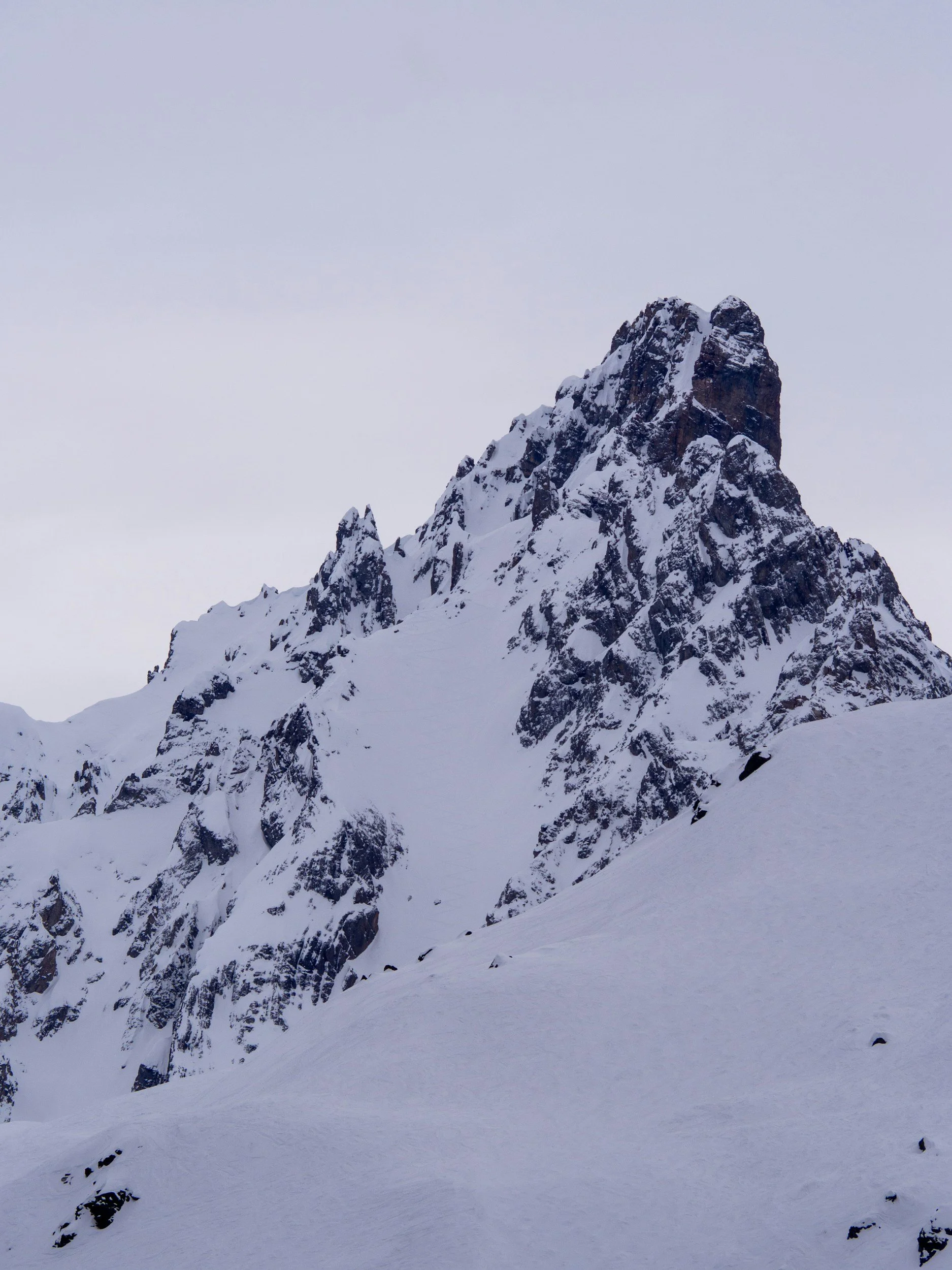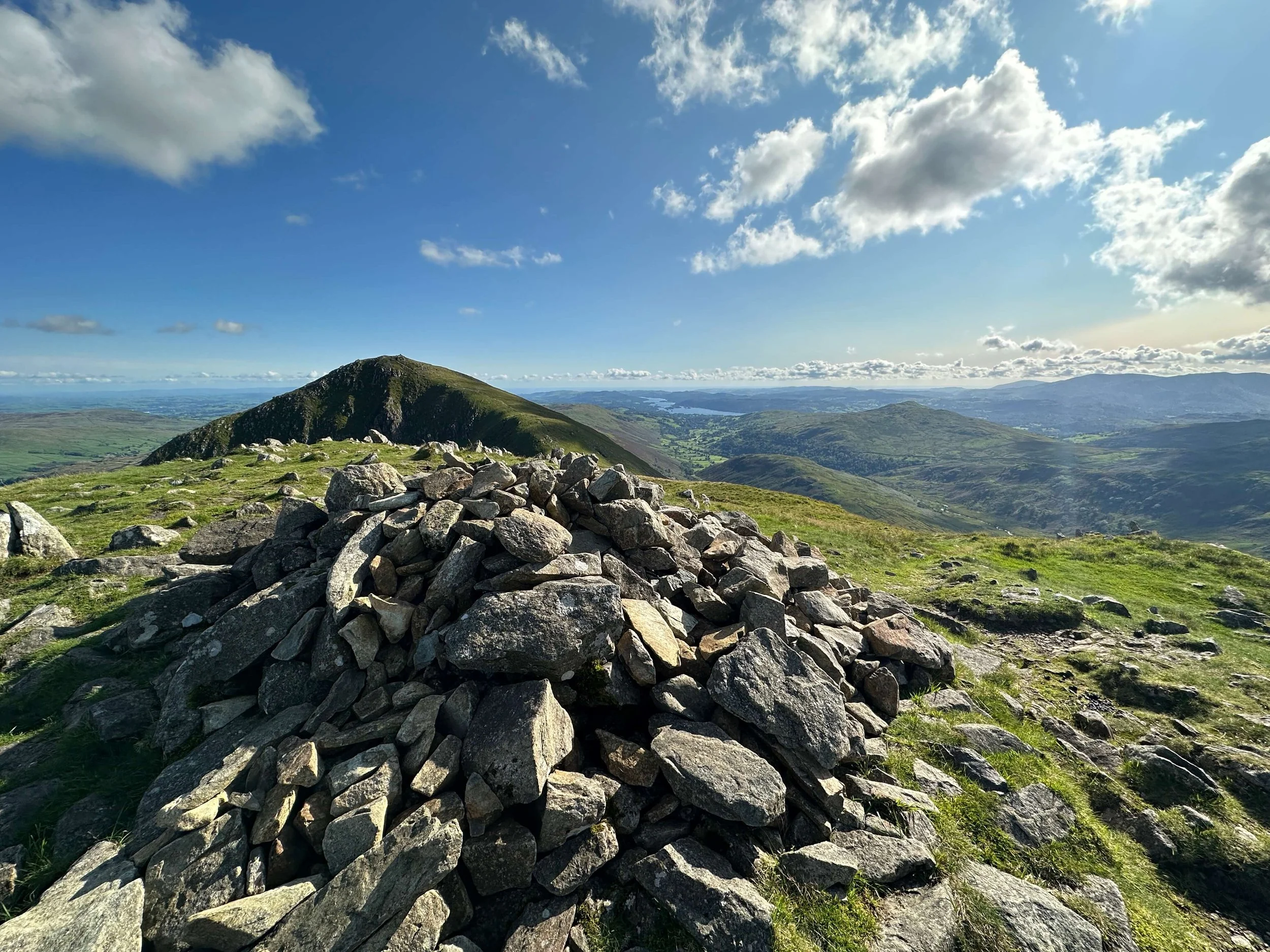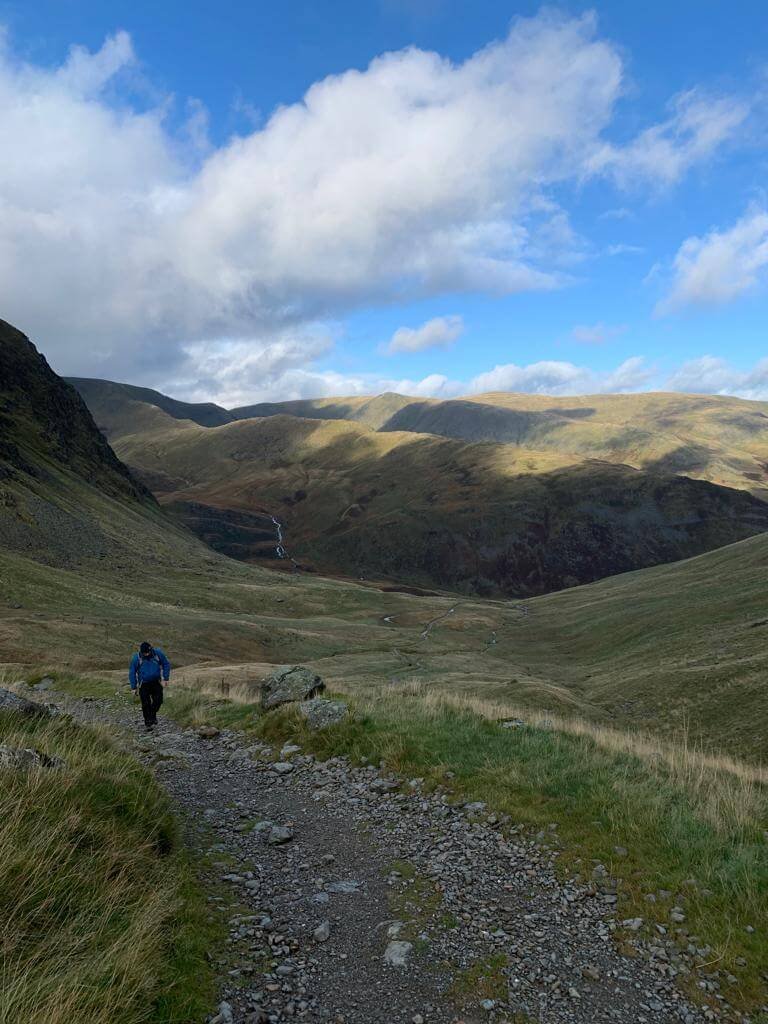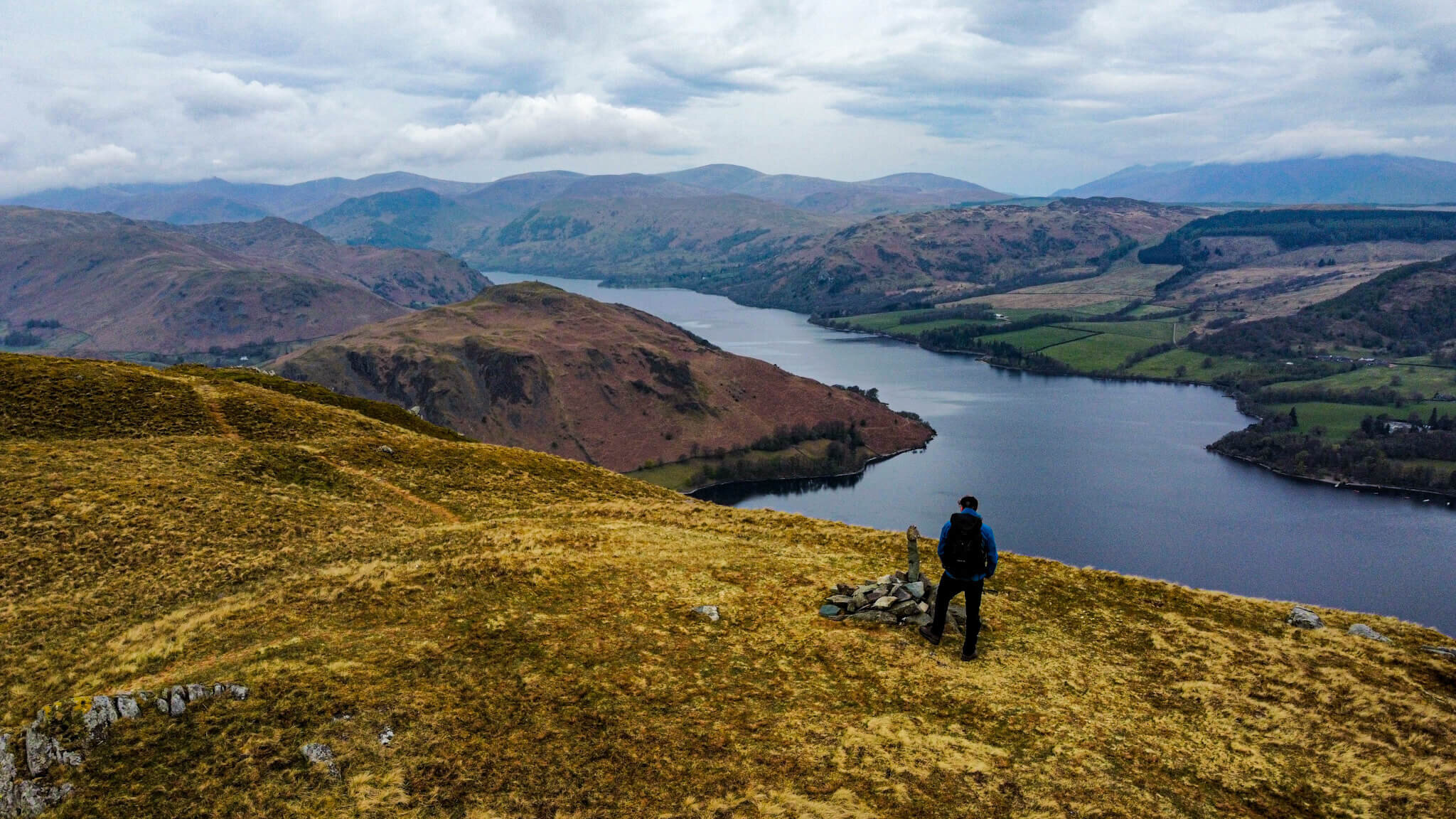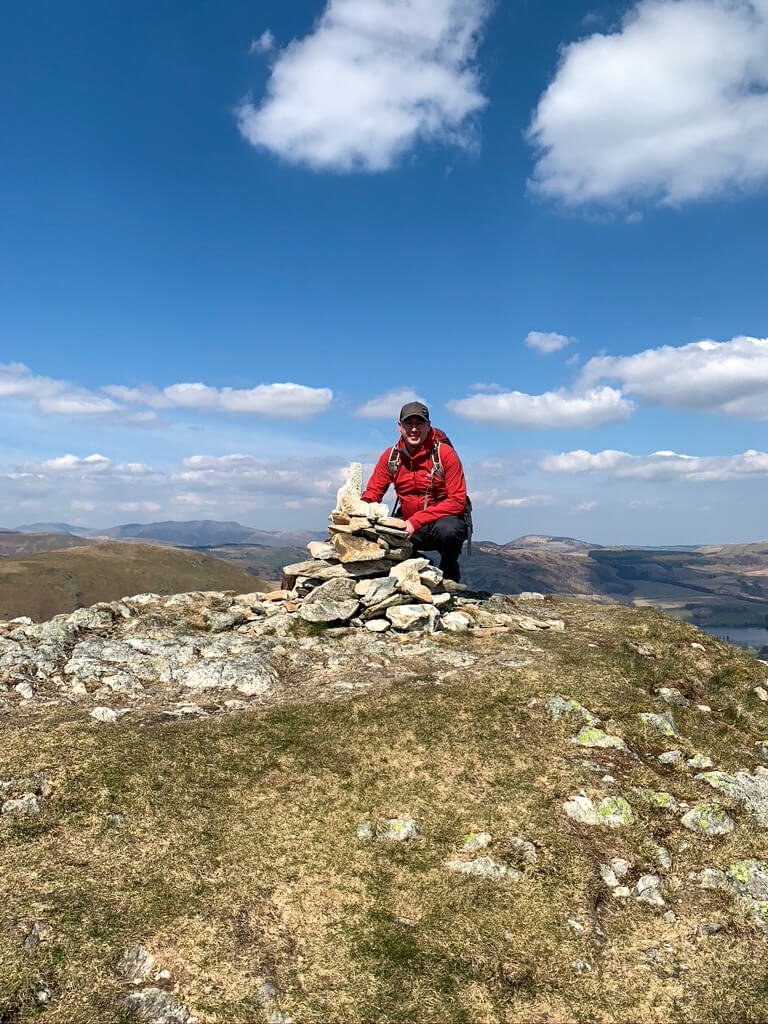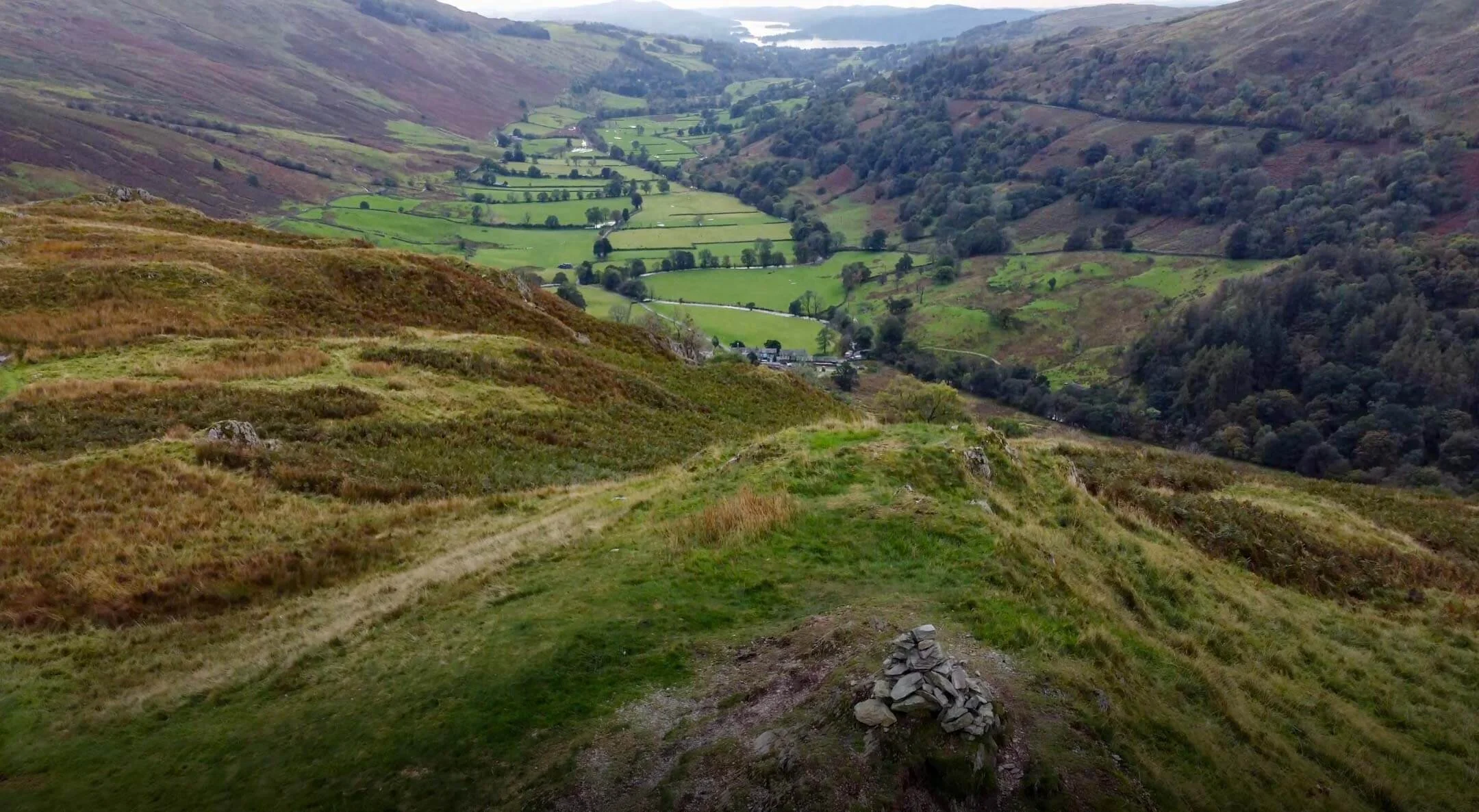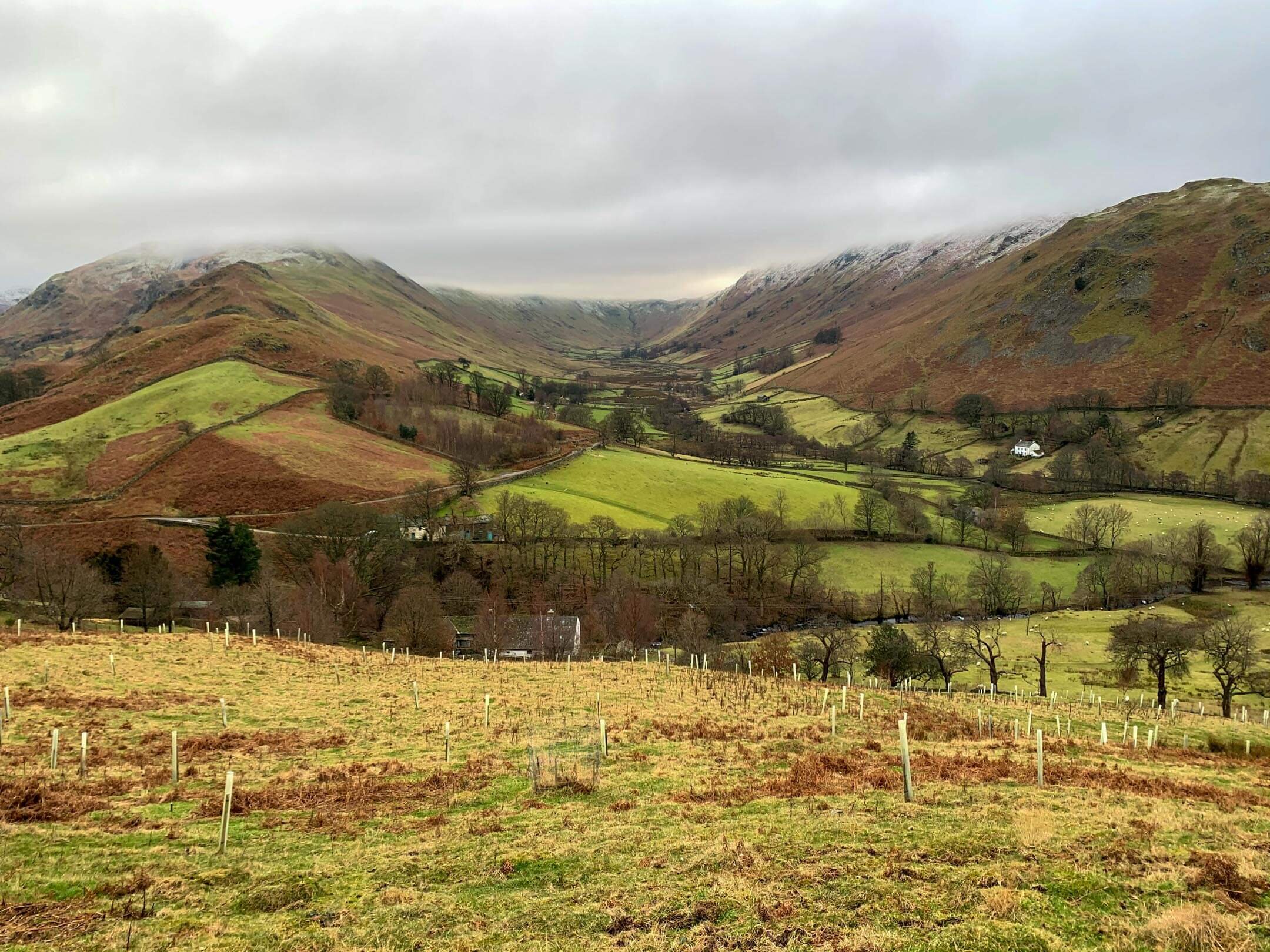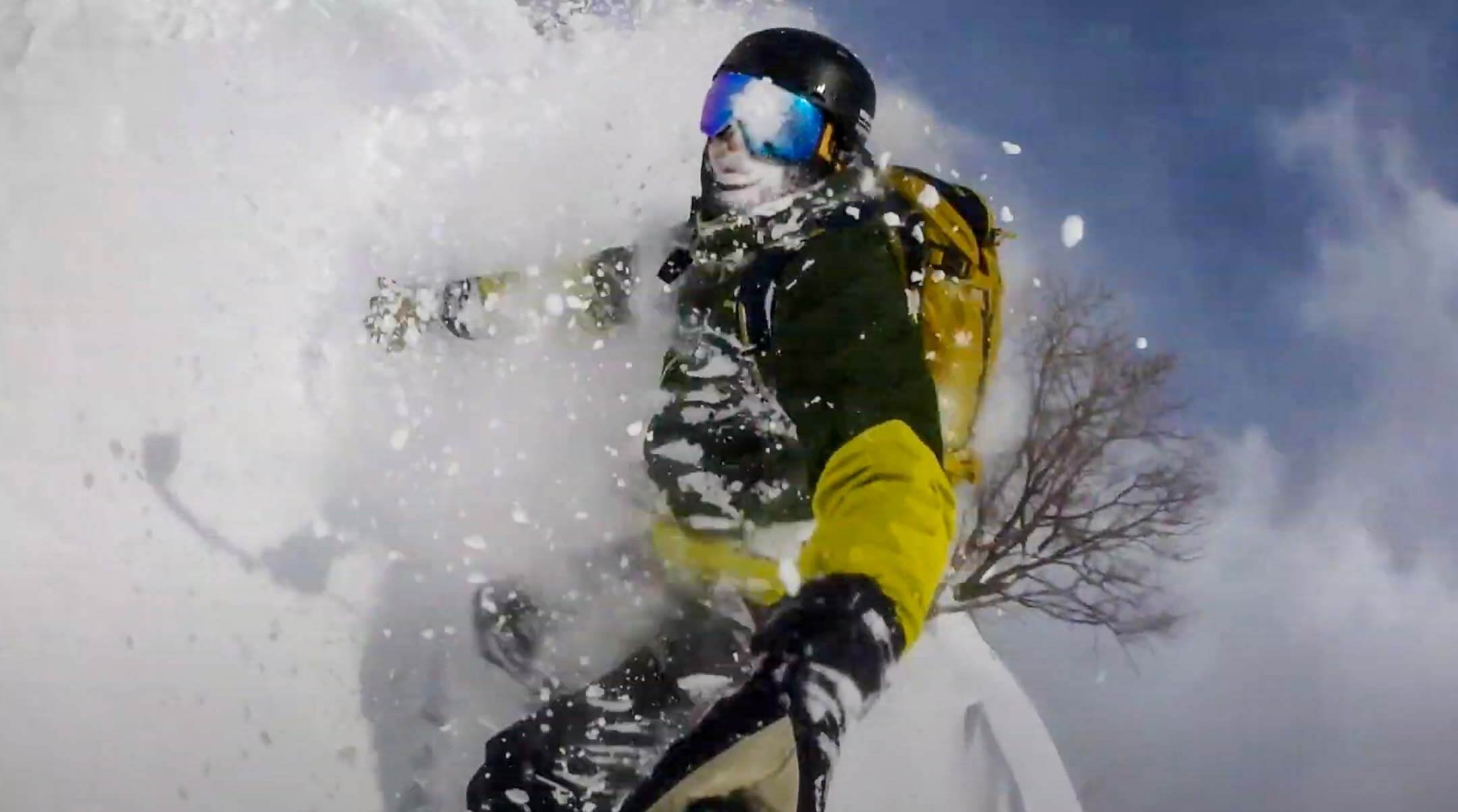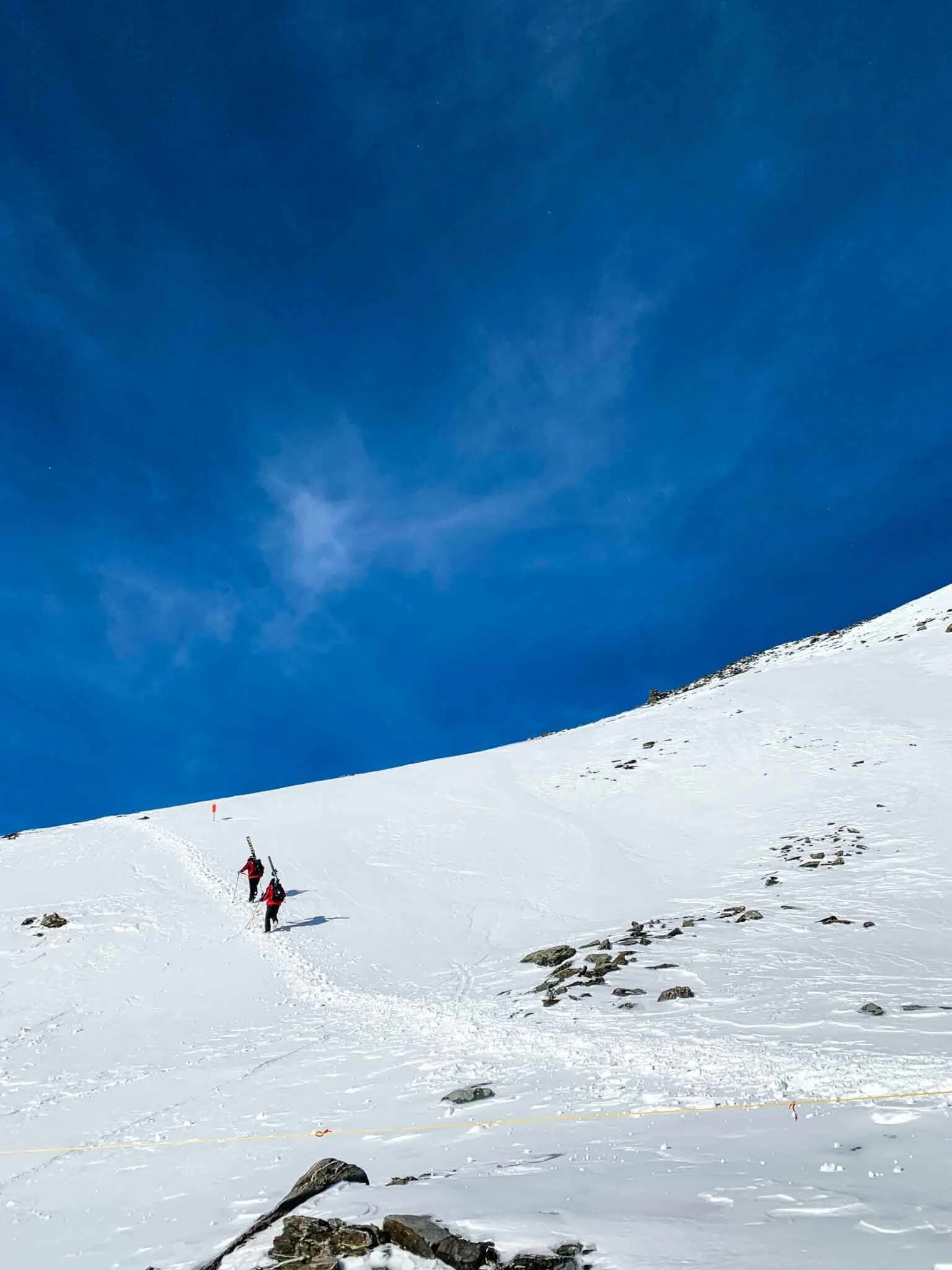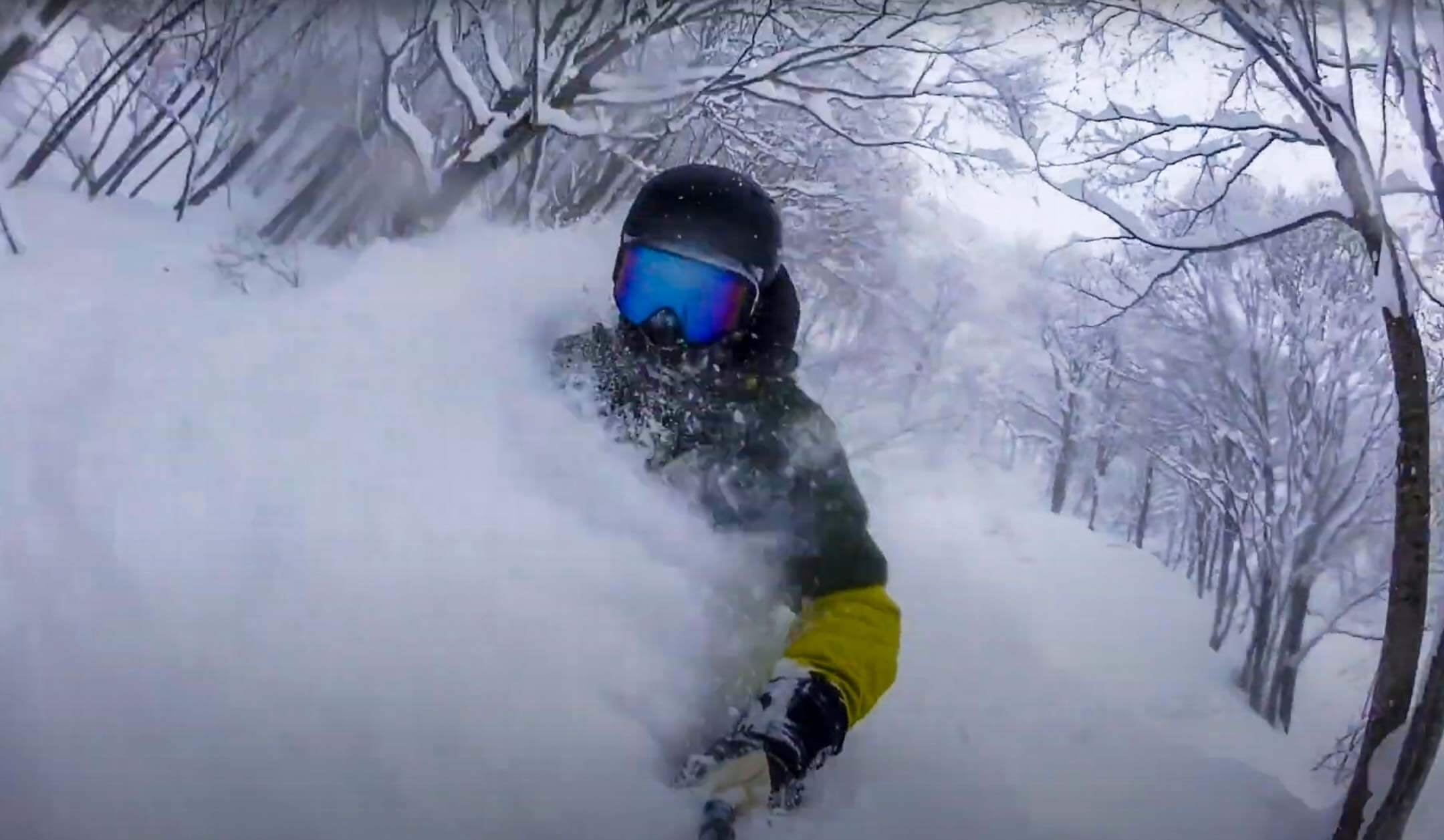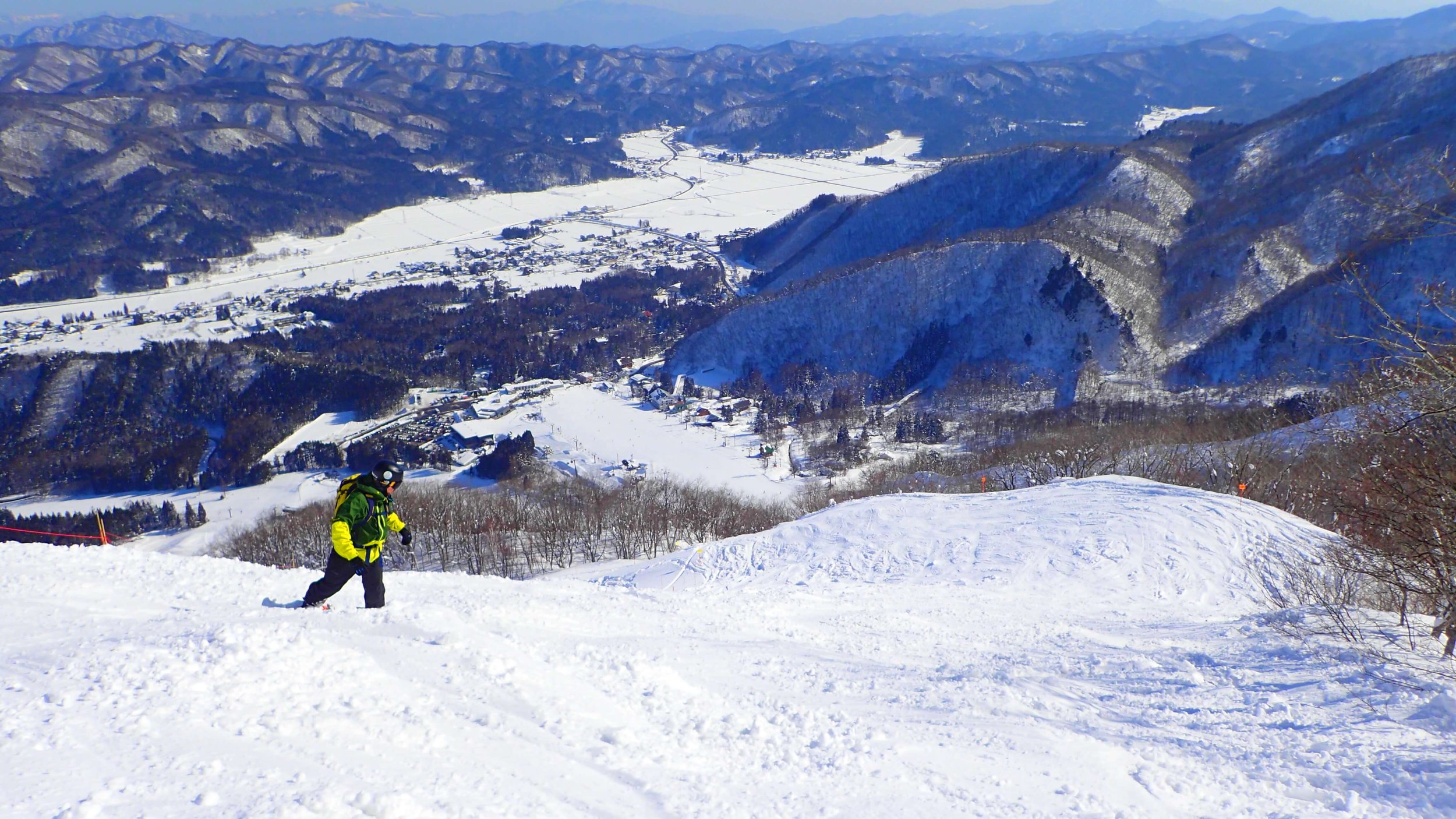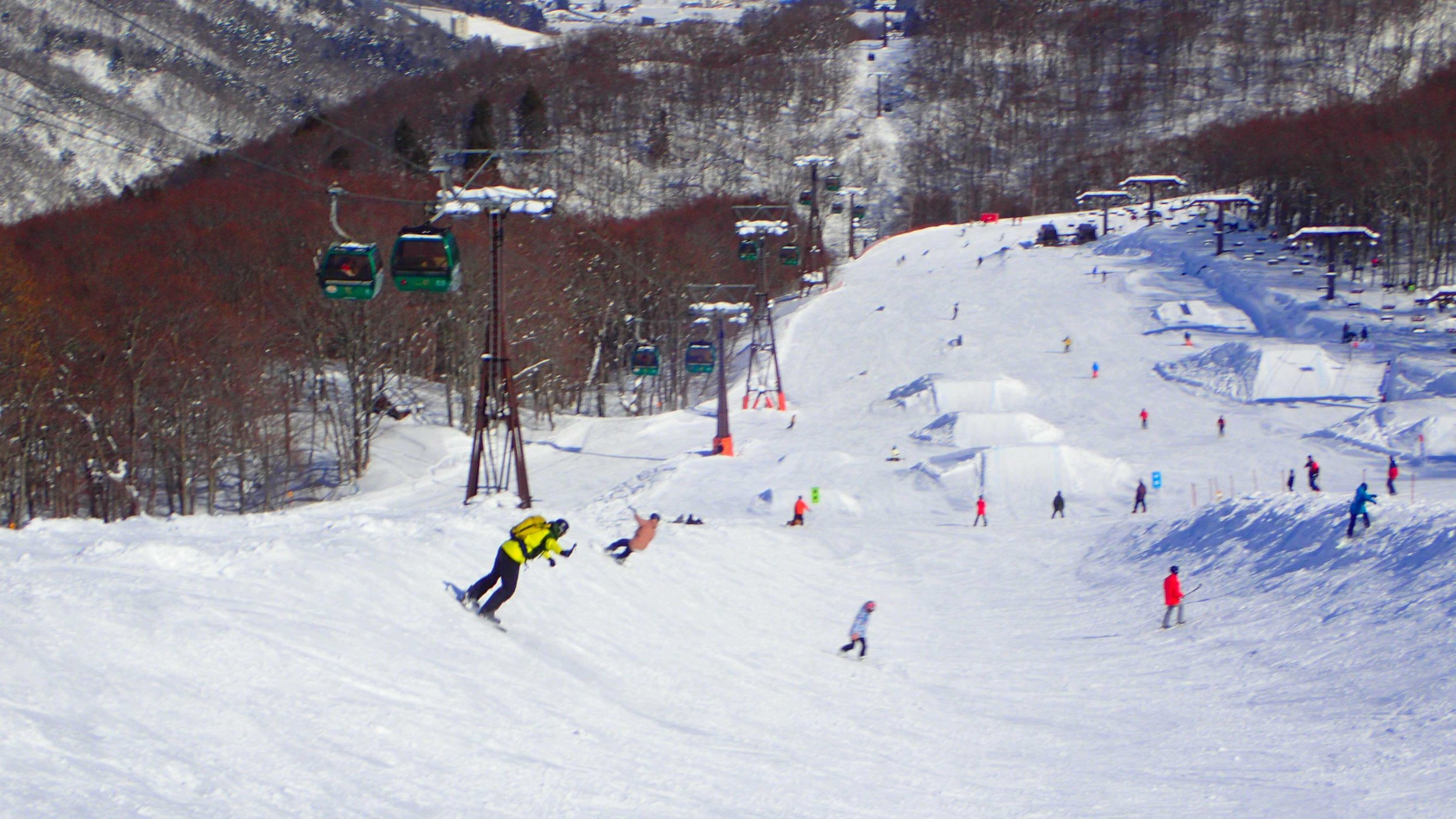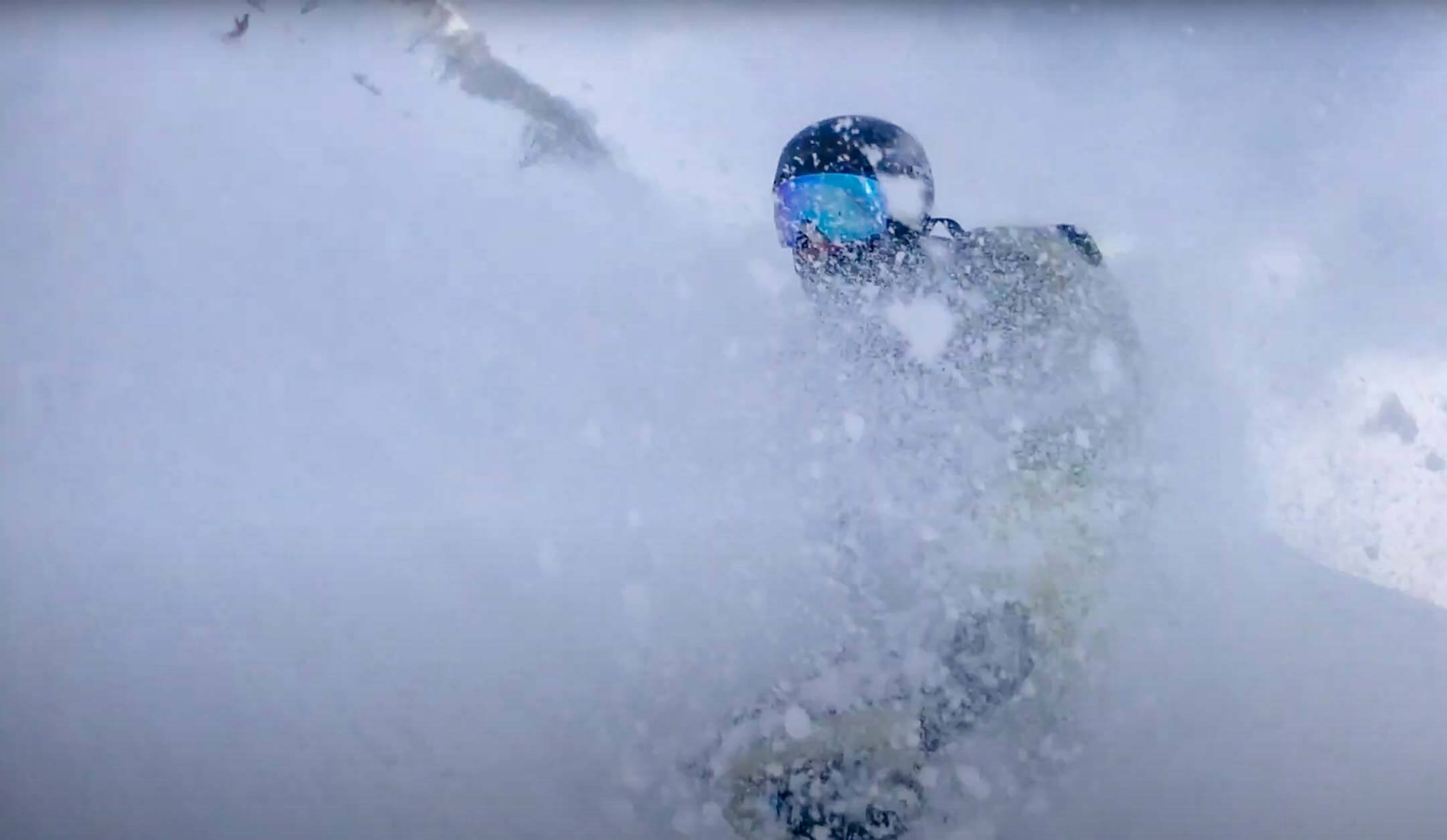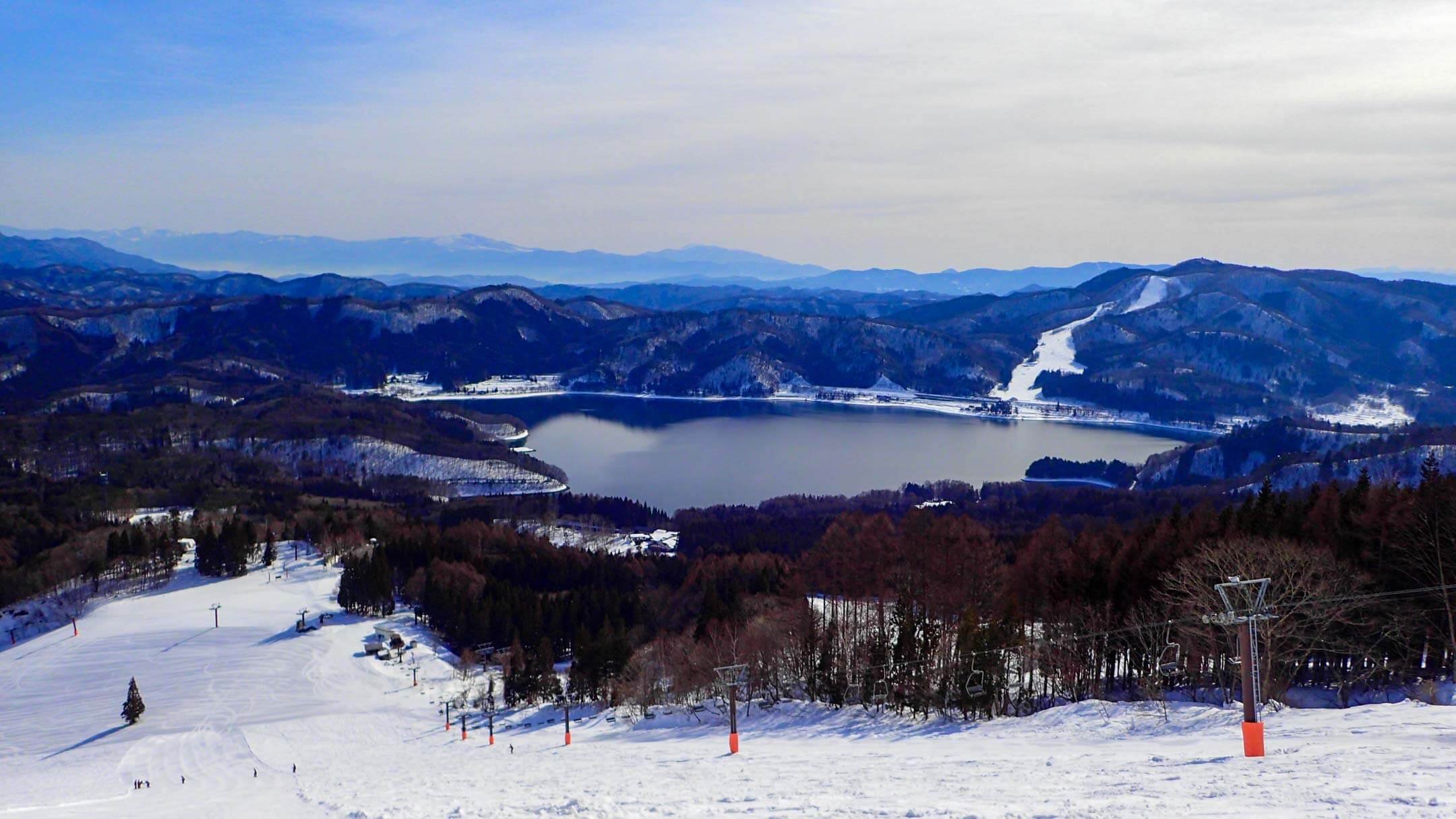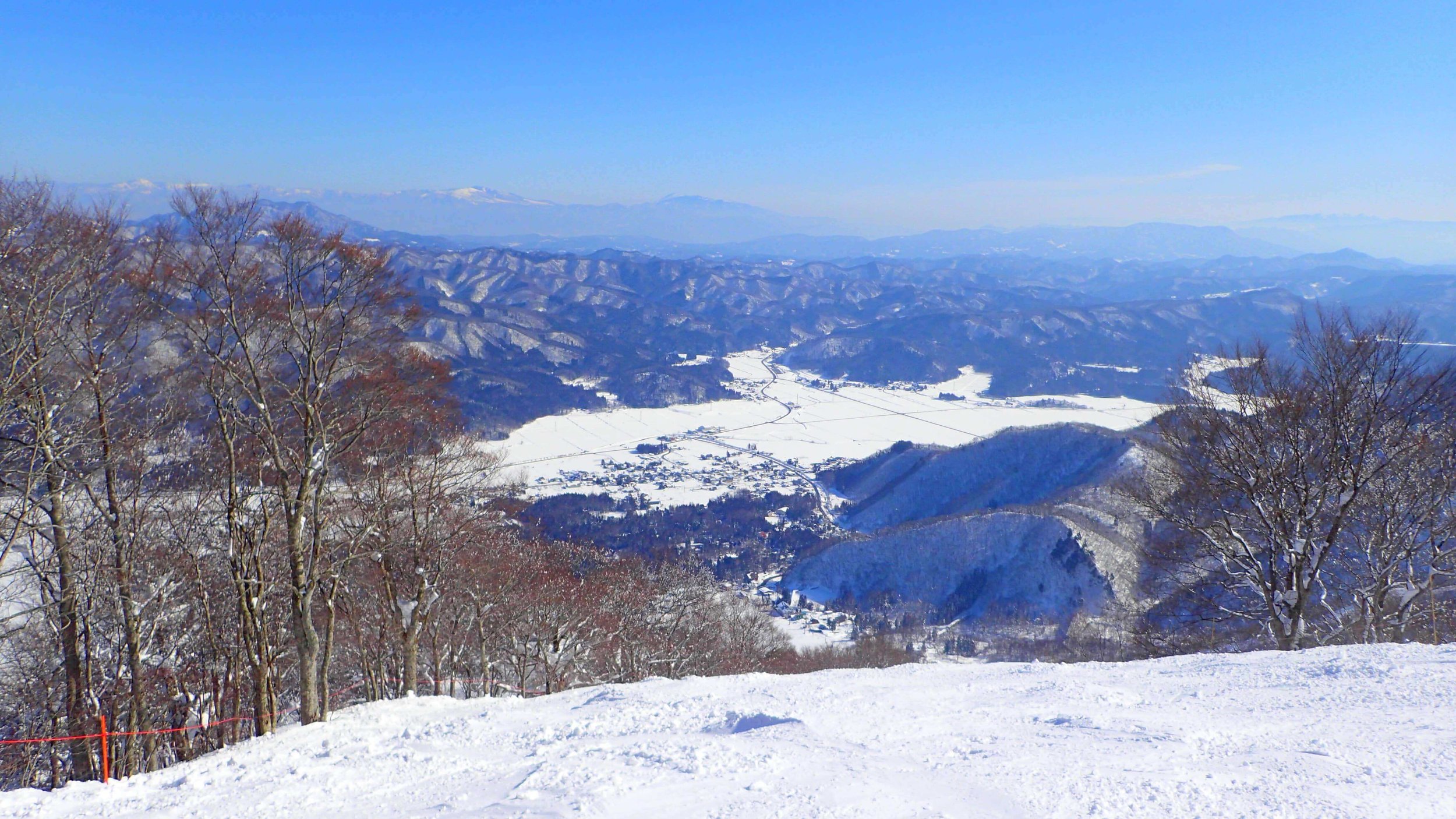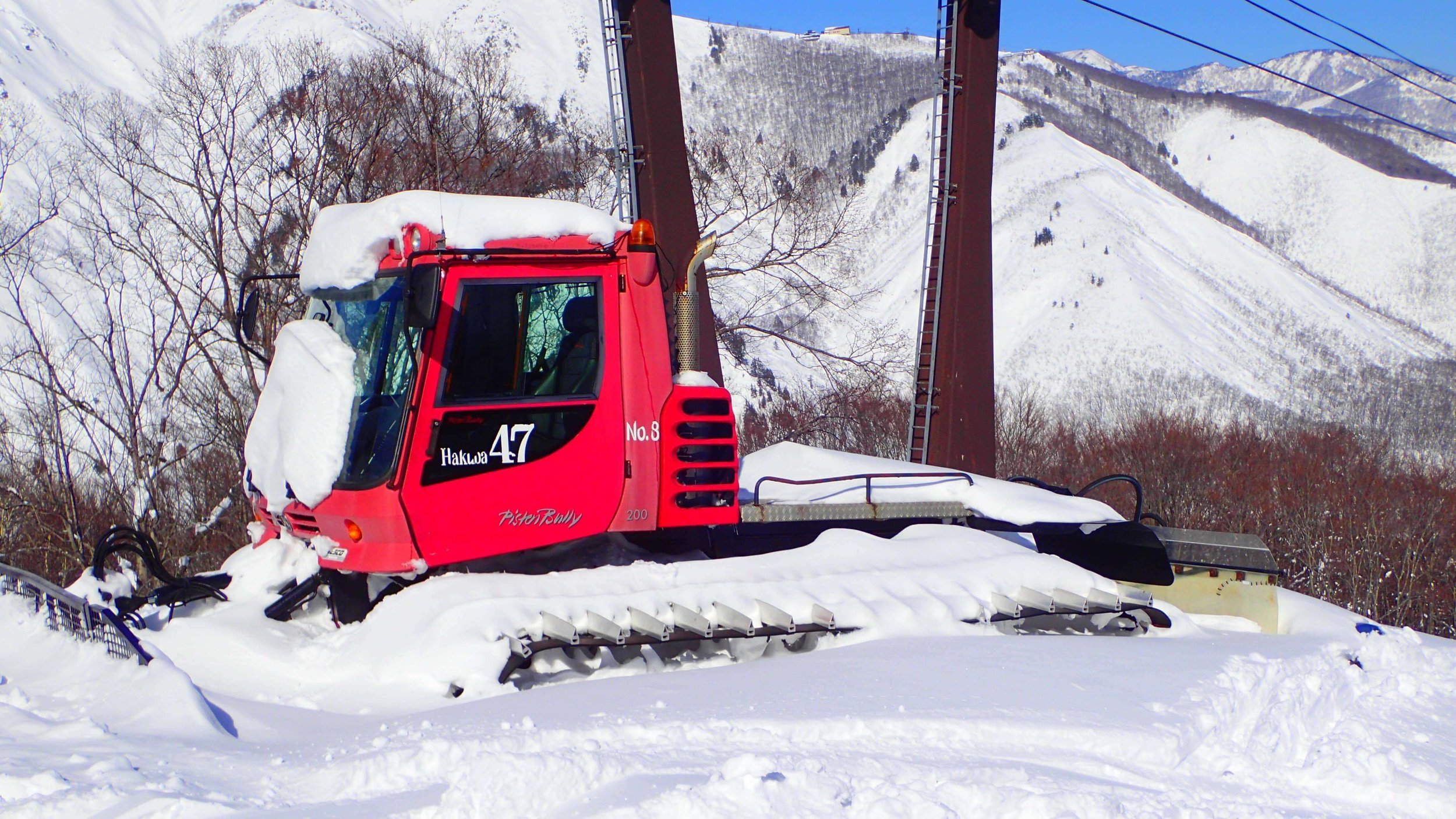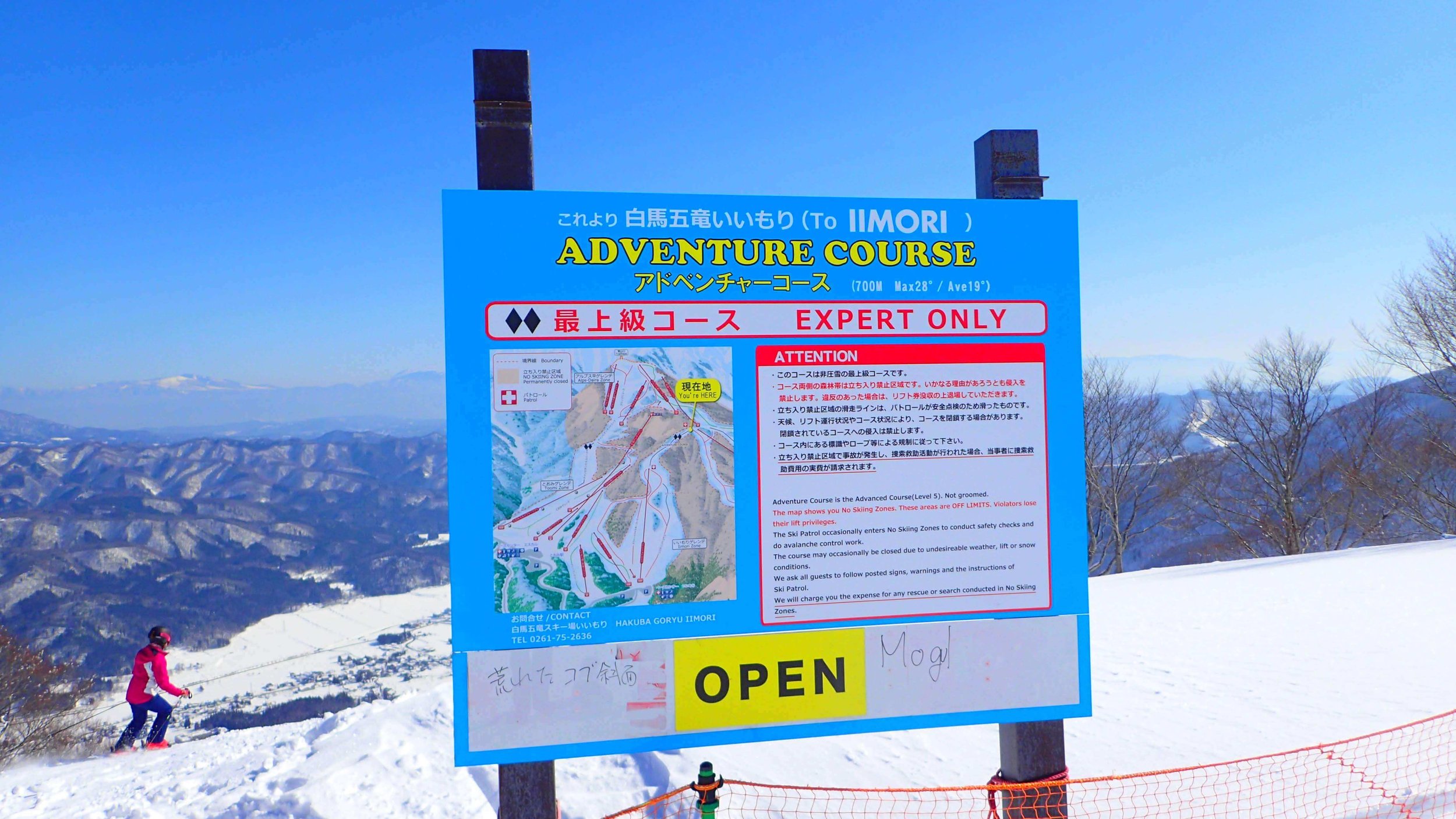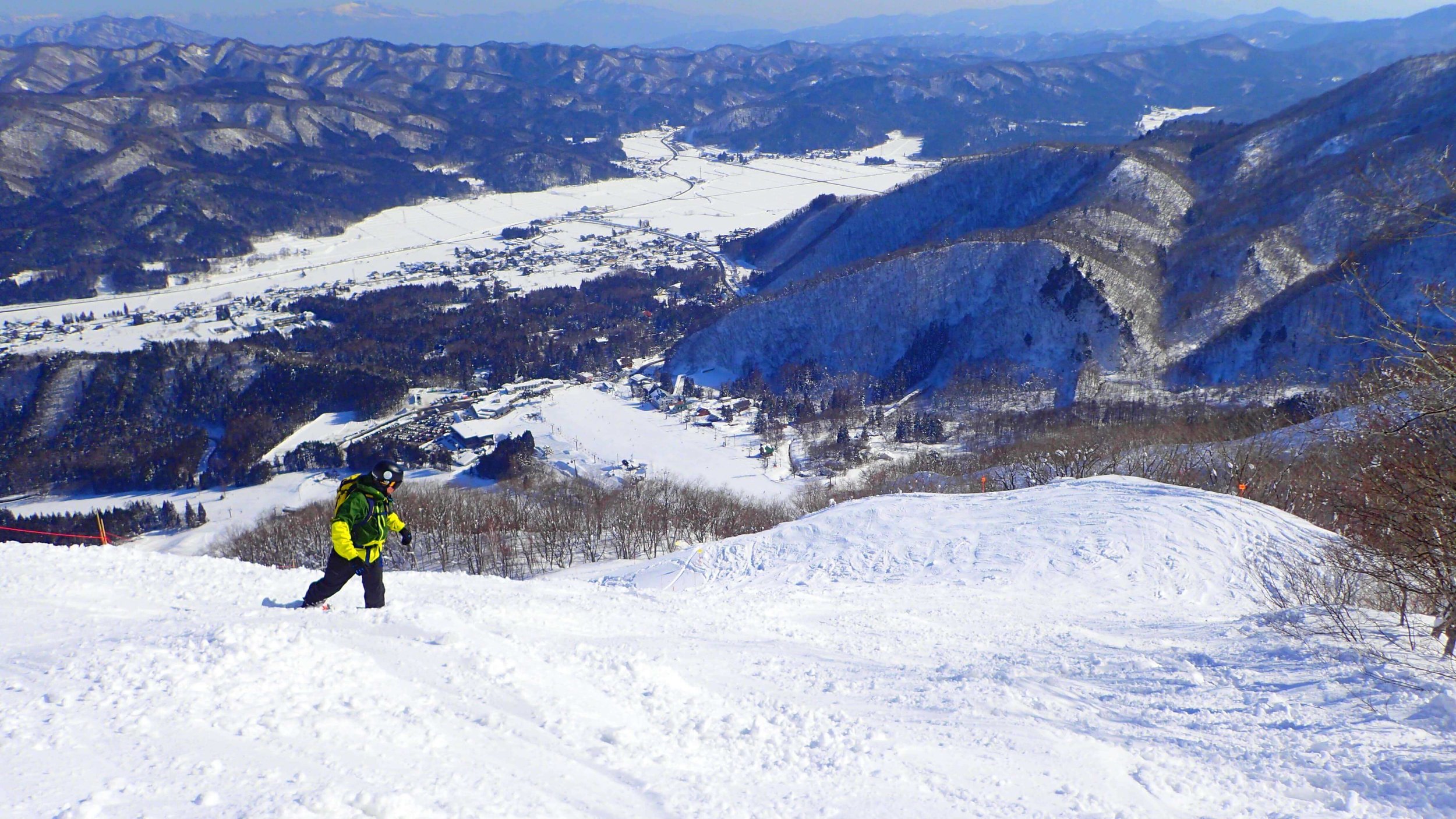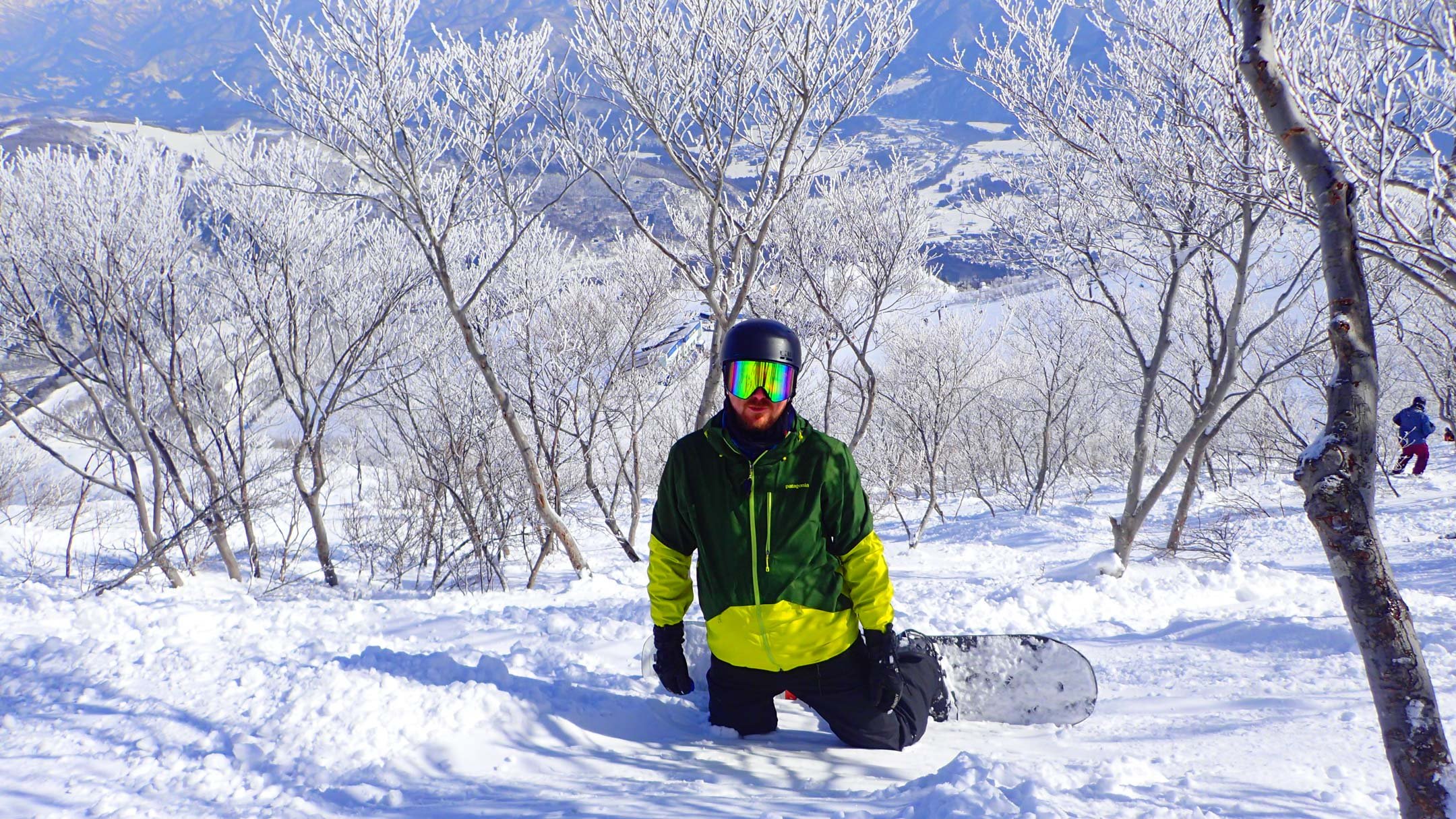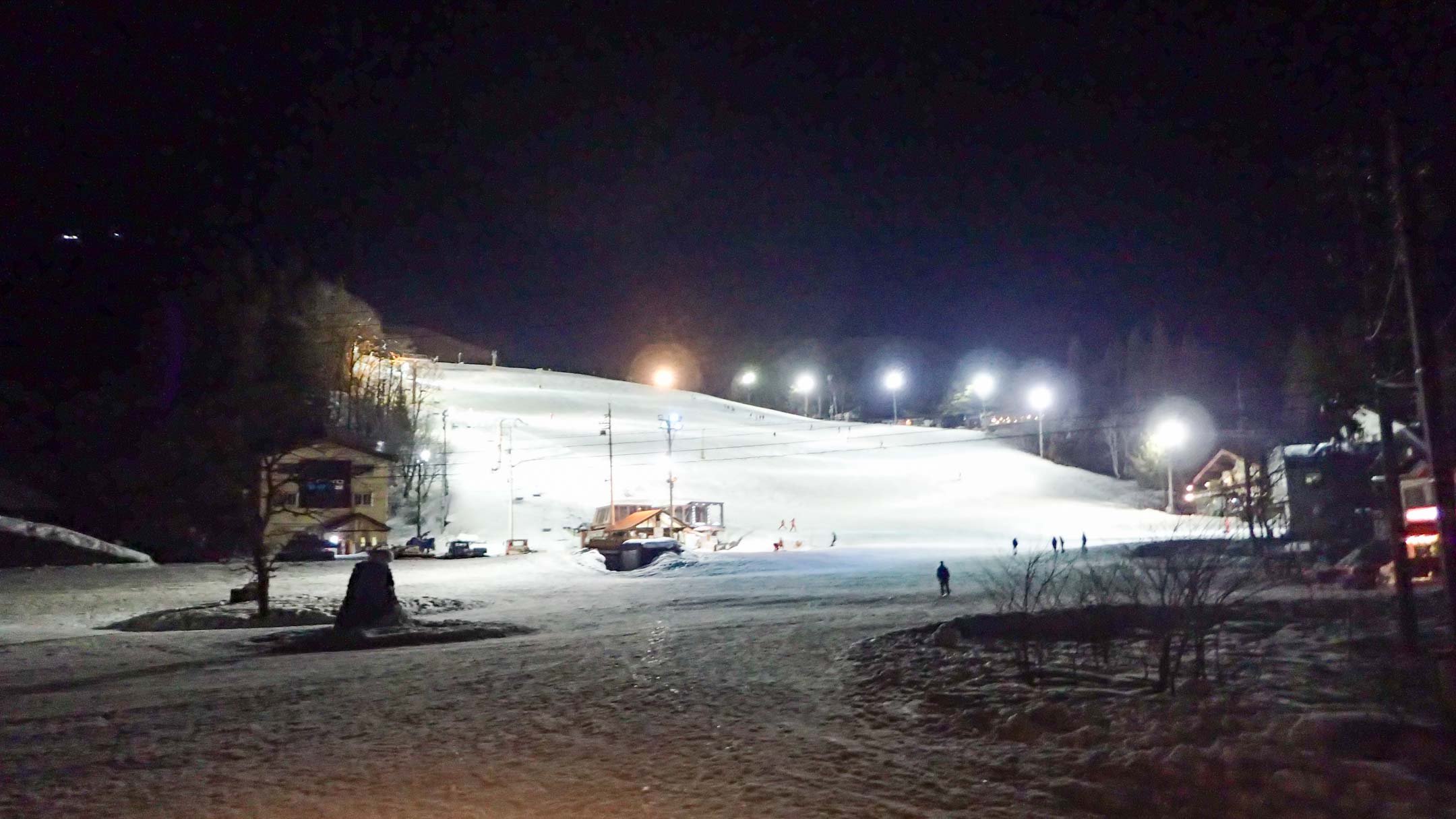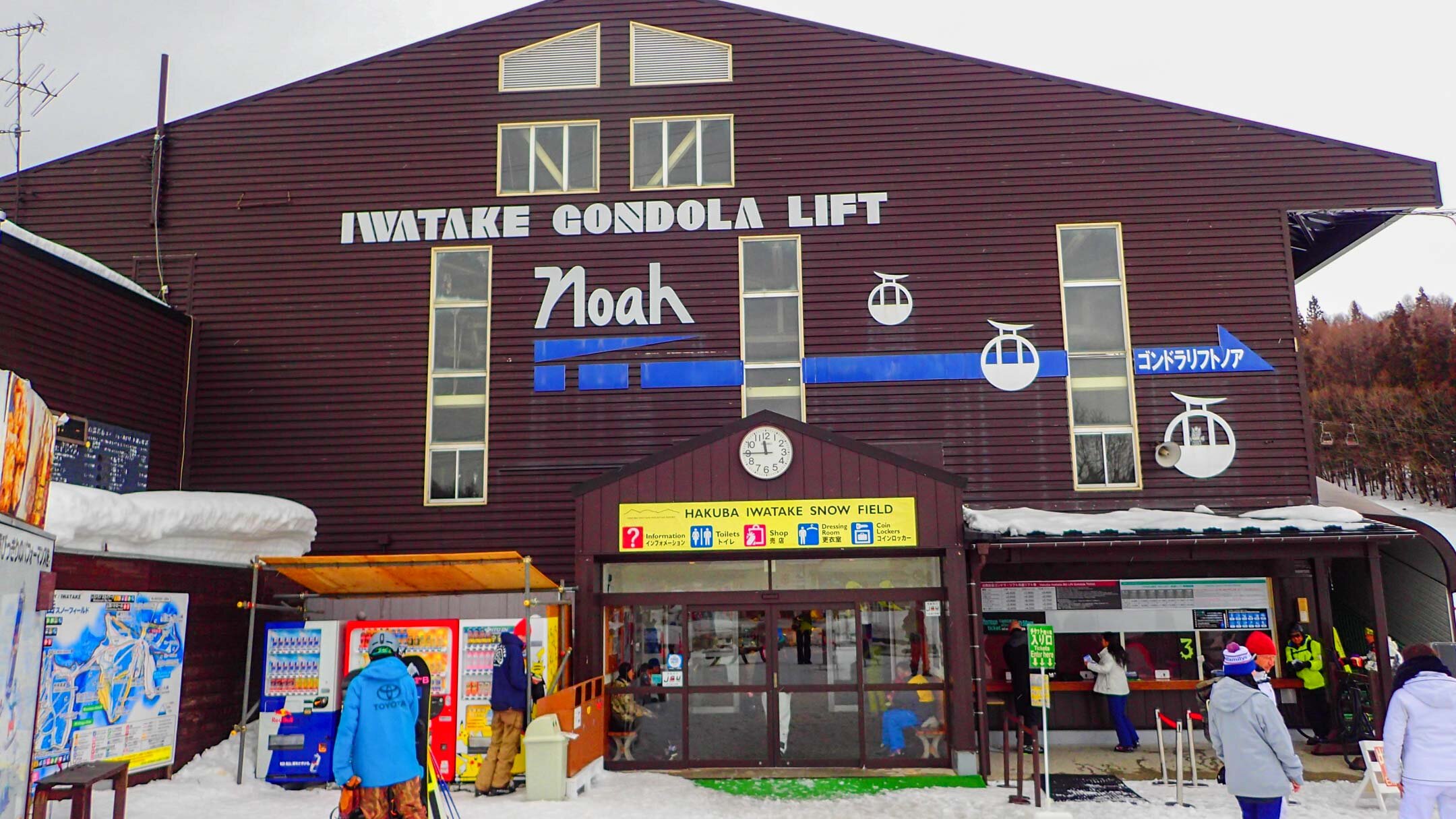Five Best Ski Runs In Hakuba Valley
The Hakuba Valley is an area of Japan renowned for world-class skiing and snowboarding. Blessed with an average of 12m of snow per winter, it is no wonder that people flock from around the globe to experience Japanese powder conditions. In this post I share the five best ski runs in the Hakuba Valley.
With ten resorts included on one pass there is an expanse of terrain to choose from when heading to Hakuba. This means whittling all the options down to a list of the five best runs possible in Hakuba was a hard task. This list is based on my experience of snowboarding in Hakuba in Jan-Feb 2019 and my fondest memories of the trip. The runs I have selected are varied and I will fully explain my reasoning below.
5. TSUGAIKE DBD GATE 3
Tsugaike is nicknamed ‘powder heaven’ and this should tell you all you need to know. Geographically it is close to Hakuba Cortina but it doesn’t draw the same crowds despite receiving similar amounts of snow. This is most likely down to the restriction on tree riding at Tsugaike, requiring you to take a course to enter to the tree areas or DBD. There are four main gates into the Tsugaike DBD area and I enjoyed the lines through Gate 3 the most. Gate 3 provides a longer run than Gate 1 with a steeper incline but the same well spaced trees!
4. HAKUBA 47 TERRAIN PARK
When you think of a Japanese snowboard trip heading to the terrain park is not what comes to mind. Sadly not every day can be a powder day and Hakuba 47 offers another option to keep you entertained during your trip to Hakuba. The terrain park at Hakuba 47 is in my opinion the best in Hakuba. The layout is great with its own (fairly slow) chairlift, making park laps a fairly simple task. Hakuba 47 has Hakuba’s only half pipe at the top of the park which leads down to a choice of lines. Skiers and snowboarders can choose between simple ride-on boxes to large kickers and more advanced rail features.
3. CORTINA CHAIR 5 TREE RUN
Cortina was bound to feature in this list and it does twice, but the run from the number 5 chairlift might be a surprise entry to some. This is where I found some of my best and less contested turns in Cortina. With the crowds that flock to Cortina if you want to make the most of it you need to get away from the crowds. Number 4 chairlift accesses some great terrain but you can expect a 40 minute lift cue on a busy day. With this in mind the trees that are accessible from Number 5 chairlift are a great option. My advice is from the top of the chairlift go left, take a short traverse and then drop in. Most skiers and snowboarders go right of the chair meaning you can find untracked lines well into the afternoon. Whatever chairlift you use at Cortina will lead to widely spaced trees and copious amounts of JAPOW! Taking chairlift number 5 just means you don’t need to share.
2. SANOSAKA LAKE DOWN TRAIL
Sometimes good things come in small packages and Sanosaka is a prime example. Making the list at number two is my favourite non-powder day run in Hakuba, Lake Down Trail. It blows my mind how quiet this resort is and you can have the groomers to yourself all day. Lake down trail is a wide blue run offering great views of Lake Aoki. Stood at the top you have the option to take the groomed piste or go to skiers right where there is a pump track… as the run mellows out towards the chairlift, you will also find some small park features. This means in one run you can; take in a great view, carve a groomer, build up speed on the pump track, hit a jump, slide a rail and then head up for some more…. oh did I mention dogs are allowed? So be sure to keep an eye out for a furry friend.
1. CORTINA TO NORIKURA BACKCOUNTRY RUN
Hakuba Cortina not only has no restrictions on where you can tree ride but it is also linked to neighbouring resort Norikura Onsen Ski Resort. From the top of number 4 chairlift at Cortina, you can access a backcountry run that takes you between the two resorts and this was a highlight of my days at Cortina. As soon as you drop in you are met with perfectly spaced trees and a steep incline that make face shots a regular occurrence. The amount of snow combined with the terrain makes this a run I have not found elsewhere on my snowboard travels. You will want to gradually ride towards skiers left as this will take you towards Norikura resort where you will be able to head back up and do it all again.
Have you visited Hakuba? Do you have a favourite run? Let me know in the comments.
RELATED POSTS
Norikura Onsen Ski Resort Guide
Norikura or Norikura Onsen Ski Resort is one of the ten resorts included on the Hakuba Valley ski pass. Much less westernised than other ski resorts in the valley, Norikura feels a world away from Hakuba Village. You will not find any large chain rental shops or bustling restaurants at Norikura but you will discover an authentic Japanese skiing experience. Much quieter than the resorts of Happo or Goryu, it can feel like you have the resort to yourself which is always an incredible feeling.
HAKUBA NORIKURA ONSEN FIRST IMPRESSIONS
Arriving at Norikura feels a little different to arriving at the other Hakuba Valley resorts. To start with, if you are taking the free Hakuba Valley shuttle buses you will notice that most people stay on the bus and head to the neighbouring Hakuba Cortina ski resort. It is a strange feeling to arrive somewhere with a bus of 50 people and be the only person to get off! Once off the bus, you will not notice any major infrastructure other than the hotels at the base of the resort. You will walk straight off the bus and onto the chairlifts!
The second noticeable thing was the lack of crowds at Norikura. The majority of skiers and snowboarders appeared to be Japanese and I could count the western visitors I noticed on one hand. Once away from the base area, which has some mellow beginner slopes, don’t expect lift lines because there aren’t any!
HAKUBA NORIKURA ONSEN SKI AREA
Similar to most of the resorts in Hakuba you will not find a particularly large ski area at Norikura. With only 500m of vertical drop 1300m-800m and 14 trails, it’s a good job that Norikura is linked to its neighbour resort Cortina. The link to Cortina adds an additional 16 runs to the Norikura ski area which should be enough to keep most people occupied for a week of skiing or snowboarding, especially when you consider the amount of snow these resorts receive.
There is nothing particularly challenging about the terrain on the Norikura Onsen side with perhaps the most challenge to be found in the trees. The tree riding at Norikura is similar to Cortina in that it is open with skiers and snowboarders taking responsibility for their own riding in these areas. With 80% of the terrain marked as beginner or intermediate, those looking for a challenge should take the connecting lifts over to Hakuba Cortina where the runs are steeper. For those staying on the Norikura side, you will face less competition for your turns.
FREESTYLE TERRAIN NORIKURA ONSEN SKI RESORT
The ski area at Hakuba Norikura has a terrain park which features a good-sized half pipe. You will also find a border cross course and freestyle moguls set up. The freestyle terrain at Hakuba Norikura Onsen is minimal and if freestyle is your main interest you should consider visiting Hakuba 47 ski area.
BEGINNERS TERRAIN NORIKURA ONSEN SKI RESORT
If you are a beginner you will find that Norikura is a great place to learn and to have easy progression. There are some nice mellow runs just opposite the Hakuba Alps Hotel, near the bus stop, accessible from lift 1. Similarly, the green trail beneath the No. 6 chair will be enjoyable for beginners. A real perk of skiing or snowboarding at Norikura as a beginner is the lack of crowds. The runs at Norikura allow plenty of space to practice your turns without worrying about crashing into other skiers.
INTERMEDIATE TERRAIN NORIKURA ONSEN SKI RESORT
Norikura Onsen ski resort is great for intermediates looking to take their first steps into tree skiing. The tree runs here are widely spaced and lack the steepness found at neighbouring resorts. This combination makes tree skiing here less worrying and more enjoyable. Partner this with the copious amounts of snow received at Hakuba Norikura and this could be the perfect intermediate powder playground.
ADVANCED TERRAIN NORIKURA ONSEN SKI RESORT
The aptly named Expert course at Norikura is one of the few black trails on offer within the bounds of the resort. Just like other black ski trails at Norikura Onsen, the Expert Course is short and over in a flash. A real treat for expert skiers is the backcountry run between Hakuba Cortina and Norikura. This route can be lapped starting in Cortina and finishing at Norikura Onsen.
The nice thing about off-piste skiing at Norikura and the neighbouring Cortina ski resort is the lack of restrictions. A number of ski resorts in the Hakuba Valley require you to attend safety briefings (Tsugaike Kogen) or to register with ski patrol (Hakuba 47). This can be a bit… over the top when you compare the terrain you can access at European resorts without restrictions. The freedom to ski in the tree areas at Norikura and Cortina is perfect, especially on a powder day! Just be careful as the amount of snow you will encounter is probably much more than you are used to!
LIFTS AT NORIKURA ONSEN SKI RESORT
In what seems commonplace for Japanese ski resorts, Norikura has nearly as many lifts as trails. The nine total chairlifts are fairly basic and run at a mild speed without being overly slow. I guess the low vertical means you don’t spend too long riding the chairs.
No.3 and No.5 Pair lifts will offer the most challenge at Norikura Ski Resort. These chairs access the steeper terrain in the resort. Beginners will enjoy the terrain under the No.6 chair which offers mellow green ski trails back to the base area.
SNOW RECORD AT NORIKURA ONSEN SKI RESORT
The ski resort of Hakuba Norikura is situated to the North of the Hakuba Village close to Hakuba Cortina and Tsugaike Kogen. This end of the Hakuba Valley is best known for receiving the most snowfall and makes it the place to go for powder turns. If you are an experienced skier or snowboarder you should make the most of the linked ski pass that Norikura shares with Hakuba Cortina as this will allow you to make the most of the great tree skiing in the area.
NORIKURA PISTE MAP
SEASON DATES
The ski seasons at Hakuba Norikura typically runs between December and April with the best skiing found between the end of January and the end of February. It is during this period that Norikura receives massive amounts of snow fall. There is a reason they call it “Japanuary”.
TRAVEL TO NORIKURA
Where is Norikura Onsen
Norikura Onsen ski resort is in-between two of the most popular resorts in the Hakuba Valley. On one side is Tsugaike Kogen ski resort known for its DBD tree skiing area. On the other is Hakuba Cortina, which is close enough to be linked via chairlift to Norikura Onsen. This part of the Hakuba Valley receives the most amount of snow and it is here you will want to head for the best Japanese powder skiing.
How to get to Hakuba Norikura
Free shuttle buses run to Norikura via Tsugaike and Iwatake ski resorts. The buses do not run very frequently so you will have to check the most up-to-date timetable. On your way back to Hakuba village the bus will leave Cortina before reaching Norikura which can mean that seats are few and far between. The drivers try to save seats on a busy day.
NORIKURA ONSEN ACCOMMODATION
If you wanted a more relaxed feel for your Hakuba holiday you could base yourself in Norikura. The Hakuba Alps Hotel is at the base of the slopes and would represent a good ski-in ski-out option. Alternatively, there is lots of accommodation options in Hakuba village and really depends on your preferences and budget. I stayed in a guesthouse which was fairly basic but provided a space to cook, wash and sleep.
NORIKURA PROS
Norikura Onsen main selling point for me would be the lack of crowds. There is less waiting in line, less competition for first tracks and more room on the pistes.
Being a linked ski area Norikura and Cortina combine to make one of the larger ski areas in the Hakuba Valley. This means there is more terrain to keep you occupied without having to repeat the same runs.
The backcountry run between Hakuba Cortina and Norikura Onsen ranked number 1 in my Five Best Runs Hakuba Valley
The resorts of Tsugaike, Norikura and Cortina receive larger amounts of snow than the other Hakuba Valley ski resorts.
Free shuttles are available to Norikura Onsen Ski Resort from the Happo Bus Terminal
NORIKURA CONS
Although free shuttle buses connect Norikura to Happo Bus Terminal and the other Hakuba resorts, they do not run as frequently. This can make inter-resort travel a little tiresome.
No major challenge for advanced skiers or snowboarders meaning you could find yourself repeating certain runs.
NORIKURA VIDEOS
NEARBY SKI RESORTS
NORIKURA ONSEN FINAL THOUGHTS
Hakuba Norikura Onsen Ski Resort was great to visit for its more relaxed vibe and I found myself visiting the combined Cortina-Norikura ski area multiple times throughout my trip. Although by staying on the Norikura side you may sacrifice some challenge, I do feel it’s worth it for less competition for fresh snow.
A Guide To Snowboarding In The Hakuba Valley Japan
When people are writing lists of their dream ski and snowboard experiences Japan is never far from the top. The Hakuba Valley and its 10 unique ski areas may just be amongst the most sought-after ski experiences in the world. Nestled within the heart of the Japanese Alps, the Hakuba Valley has rightfully earned its reputation as a premier destination for skiers and snowboarders seeking pristine powder, breathtaking landscapes, and a unique cultural experience. If you're a winter sports enthusiast looking for your next adventure, here's a comprehensive guide to skiing in the Hakuba Valley.
Powder Days at Hakuba Cortina ski resort
HAKUBA’S MAIN INGREDIENT
When choosing your ski destination there is one really important ingredient that surpasses all other requirements, snow! Without snow, it’s not a ski holiday. Luckily for the Hakuba Valley, it just may be amongst the snowiest destinations on earth. Hakuba gets blanketed in fresh snow between December on April, with an incredible average of 12m per winter. This incredible snow record combined with the diverse terrain on offer within the Hakuba Valley makes it an exceptional place to ski and snowboard.
ABOUT THE HAKUBA VALLEY
The Hakuba Valley is a combination of 10 ski resorts set amongst the beautiful backdrop of the Japanese Alps. The 10 Hakuba Valley ski areas are all included on the same lift pass making it really easy for skiers and snowboarders to navigate the different resorts. The real beauty of this combined ski area is found in the variety of the terrain, ensuring that everyone, expert through beginner has somewhere suitable to ski for their ability.
IF YOU FIND VALUE IN THIS POST CONSIDER CLICKING THE BUYMEACOFFEE LINK BELOW TO SUPPORT MY CONTENT
GETTING TO THE HAKUBA VALLEY
The Hakuba Valley is located on Japan’s main Island Honshu. Easily accessible from the major cities of Tokyo and Nagoya, there are options to visit Hakuba by train, bus, or private car. The closest airport to the Hakuba Valley is Tokyo’s Narita airport where you can catch a direct coach or the fast trains via Nagano.
TRAIN
Popular with many visitors to Japan a trip on the fast Japanese railway is well worth doing. From Tokyo, you will want to board the Hokuriku Shinkansen (Bullet Train) destination, Nagano. This section of the journey takes 1.5-2 hours.
In Nagano transfer train to the Oito Line destination Hakuba Station. This one-hour train ride drops you in the centre of Hakuba where regular buses run. From here it is also possible for many accommodations to collect you.
When travelling by train be sure to take advantage of the luggage transfer option direct from Tokyo Airport to your Hakuba accommodation. Baggage transfer can be arranged via the counters in the arrivals area and normally takes 24 hours. Expect to pay around 2000 yen per bag but this is weight dependent.
BUS
The easiest least fuss way to reach Hakuba is by bus directly from the airport terminal. Services are available from both Tokyo Narita and Tokyo Haneda Airports. I booked with Nagano Snow Shuttle who I would recommend. The service provided by Nagano Snow Shuttle was excellent with coach transport into Hakuba Echoland and small mini bus transfers direct to my apartment.
BEST TIME TO VISIT THE HAKUBA VALLEY
The ski season in the Hakuba Valley typically runs from December to April. The region receives abundant snowfall, making it a haven for skiers. The best time to visit is usually January and February when the snow is at its peak, and the conditions are perfect for skiing.
SNOW CONDITIONS
The primary reason snowboarders flock to the Hakuba Valley is the exceptional quality of snow. The area receives a generous amount of snowfall from late November to early April, creating the perfect canvas for shredding the slopes and finding freshies in the epic trees. The peak snow conditions are typically seen between mid-December and mid-February. During this time, the valley is blanketed in a thick layer of powder, offering the best opportunity to score some Japow! The Hakuba Valley has an average snowfall of 12m per season with the resorts of Tsugaike and Cortina benefiting the most.
CROWDS AND ATMOSPHERE
The winter months of December and January tend to attract more tourists due to the ideal snow conditions. While this is great for the vibrant atmosphere and the chance to meet fellow snowboarding enthusiasts, it also means more crowded slopes and busier accommodations. If you prefer a quieter experience with fewer people, consider visiting in late February or March. These months offer a good compromise between great snow conditions and a more serene environment. You can always get away from the crowds in Hakuba with resorts like Sanosaka which are far further from the main village and the mega-resort of Happo One.
WEATHER CONSIDERATIONS
While the Hakuba Valley is renowned for its consistent snowfall, weather conditions can still influence your snowboarding experience. January tends to be the coldest month, with temperatures potentially dropping to sub-zero levels. On the other hand, March offers milder weather, longer daylight hours, and a higher chance of bluebird days, which are perfect for capturing stunning photos against the backdrop of the Japanese Alps.
EVENTS AND FESTIVALS
To add an extra layer of culture to your snowboarding trip, consider timing your visit with one of the valley's events or festivals. The Hakuba Snow Festival, typically held in February, features spectacular light displays and cultural performances. This provides an opportunity to immerse yourself in the local culture while taking a break from the slopes.
EARLY VS LATE SEASON
The beginning and end of the snowboarding season in Hakuba each have their own appeal. Early season, from late November to early December, offers the chance to catch the first powder runs of the year. While the snow cover might not be as deep as later in the season, you can take advantage of fewer crowds and sometimes discounted rates on accommodations and lift passes. The late season, from late March to early April, brings warmer temperatures and the potential for spring skiing conditions. It's a great time for enjoying sunny days on the slopes and taking advantage of end-of-season deals.
In conclusion, the best time to visit the Hakuba Valley for snowboarding largely depends on your preferences and priorities. If you're seeking pristine powder and a vibrant atmosphere, the heart of the winter season from mid-December to mid-February is your ideal window. However, if you value quieter slopes, milder weather, and potential cultural experiences, late February to March might be more your speed. Whichever time you choose, the Hakuba Valley promises an unforgettable snowboarding adventure amidst breathtaking natural beauty.
HAKUBA VALLEY SKI RESORTS
The Hakuba Valley in Nagano, Japan, is a paradise for ski and snowboarding enthusiasts, boasting a collection of ten diverse and captivating ski resorts that together form the Hakuba Valley Pass. This pass offers visitors access to an array of slopes, terrains, and experiences, making it a sought-after destination for winter sports enthusiasts from around the world.
When visiting the Hakuba Valley you can base yourself at one resort or make the most of the Hakuba Valley ski pass to visit as many of them as possible. Here is an overview of the ten Hakuba Valley ski resorts but if you require more information please check out the resort guides.
HAPPO ONE SKI RESORT
Happo-One is the largest and most famous resort in the valley, renowned for hosting downhill events during the 1998 Winter Olympics. With over 1,000 meters of vertical drop and a wide range of runs catering to all skill levels, it's a popular choice for both beginners and advanced skiers. Its bustling village features numerous accommodations, restaurants, and après-ski options.
Happo is the most popular ski resort in the Hakuba Valley and as such can fall foul of crowding during peak periods. Happo One ski resort offers the closest access to the village amenities so is the hassle-free option for Hakuba Valley skiing.
Happo One is famous for its backcountry terrain with many skiers and snowboarders alike visible from the highest lifted point heading into the backcountry.
HAKUBA GORYU SKI RESORT
Hakuba Goryu snow resort offers an ideal blend of terrains for all levels, from gentle slopes for beginners to challenging steeps for advanced skiers. The resort is also famous for its family-friendly atmosphere with Goryu village and base area a great place to stay for families. Its interconnected slopes with Hakuba 47 allow skiers to explore a variety of trails and enjoy stunning panoramic views.
Hakuba Goryu is easy to access from the main Hakuba Village with regular bus services available from Echoland, Hakuba station and the Bus Terminal. The majority of the terrain at Hakuba Goryu is best suited for beginners however, there are some challenging areas such as the adventure course.
HAKUBA 47 WINTER SPORTS PARK
Adjacent to Goryu, Hakuba 47 boasts exceptional snow conditions and a reputation for its excellent tree skiing and powder zones. It's a haven for freestyle skiers and snowboarders, thanks to its extensive terrain park with various jumps, rails, and features.
Hakuba 47 is linked to Hakuba Goryu so you can ski between the resorts throughout the day. Hakuba 47 is best known for its large terrain park which is one of the best in the Hakuba Valley. Hakuba 47 has a dedicated tree-riding zone so be sure to sign up for the Double Black Diamond Club when you arrive at the resort.
TSUGAIKE KOGEN SKI RESORT
Tsugaike Kogen is known for its vast area and long, wide slopes that cater primarily to beginners and intermediates. Its serene mountain environment and abundance of ski-in, ski-out accommodations create a tranquil experience. The upper areas provide more challenging terrain for those looking to improve their skills.
Tsugaike is a freeride haven with some of the best tree-skiing possible in the Hakuba Valley. To access the Tsugaike tree area called the DBD (Double Black Diamond) you must attend a free safety course. Tsugaike gets dumped on and this makes the tree skiing at Tsugaike some of the best in the area. Head to Tsugaike to chase powder turns without crowds.
IWATAKE SNOW FIELD
Iwatake Snow Field is an excellent choice for families and beginners, offering gentle slopes and relaxed surroundings. The panoramic vistas of the Northern Alps add to the resort's charm. It also features the Iwatake Snow Park for those interested in terrain park features.
Iwatake is a mere 10 minutes from the Hakuba station so accessing the resort is easy using the free shuttles. Once dropped at the gondola, Iwatake has mellow slopes on the lower mountain and more challenging terrain on the upper mountain. The best skiing and snowboarding at Iwatake can be found in the four tree areas near the SkyArc restaurant. From here you can find powder stashes for days after fresh snow.
HAKUBA CORTINA SKI RESORT
Cortina is celebrated for its heavy snowfall and stunning alpine scenery. Its challenging and varied terrains, including gladed areas and steep descents, make it a favourite among advanced skiers and snowboarders. The off-piste opportunities and deep powder runs are highlights of this resort.
Hakuba Cortina is more open-minded regarding its tree skiing than other Japanese resorts with no safety course needed to make the most of its wooded areas. Cortina tree-skiing is considered amongst the best in the world so it is no longer a secret. You may need to wait in line to score those Cortina powder turns but I can assure you it is worth the wait.
Make sure you take the backcountry run from the top lift that heads through the trees and across to the neighbouring ski resort Hakuba Norikura Onsen. This run was not just a favourite of my trip but also one of my favourite runs at any ski resort.
NORIKURA ONSEN SKI RESORT
Norikura Onsen is a quaint resort known for its natural hot springs and relaxed atmosphere. While it offers a mix of trails for different skill levels, it's especially suitable for those seeking a tranquil skiing experience away from the crowds.
Norikura really is the essence of what Japanese skiing should be. This local-focused resort has resisted the urge to pander to international tourists maintaining an authenticity lost in busier Hakuba ski resorts. The local area at Norikura Onsen is varied enough to keep the family entertained, with boarder cross, half pipe and a moguls course added for fun!
KASHIMAYARI SKI RESORT
Kashimayari stands out for its serene setting and excellent snow quality. It caters to a wide range of abilities with a mix of groomed trails and off-piste options. The resort's focus on nature and relaxation is perfect for families and those looking for a peaceful escape.
Kashimayari is disconnected from the main Hakuba village meaning accessing the resort takes longer and there are less frequent services. Although this may sound like a negative it actually plays into Kashimayari’s favour as if you make the journey you will be certain to have a more serene experience.
HAKUBA SANOSAKA SNOW RESORT
Hakuba Sanosaka is favoured for its family-friendly environment and affordable pricing. The resort's slopes cater mostly to beginners and intermediates, and its relaxed atmosphere is perfect for those seeking a laid-back skiing experience.
The views from Sanosaka over Lake Aokiiko are a highlight of snowboarding at Sanosaka. The views combined with empty pistes ensure that Sanosaka will remain one of my Hakuba highlights.
Lake down trail at Sanosaka is one of my TOP 5 HAKUBA VALLEY SKI RUNS.
JIGATAKE SKI RESORT
Jiigatake offers a more off-the-beaten-path experience, with fewer crowds and a focus on natural beauty. While its ski terrain is limited compared to larger resorts, it's a great option for those looking to enjoy the tranquillity of the mountains and explore less-travelled slopes.
WHERE TO STAY IN HAKUBA
With the variety of ski resorts and village bases on offer in the Hakuba Valley where to stay can become quite the headache. In the next section of the Hakuba Valley Guide, I will provide you with an overview of the main areas you could stay at on your visit to the Hakuba Valley.
HAKUBA VILLAGE
The central hub of the valley, Hakuba Village offers a mix of accommodations, dining options, and entertainment. This area is perfect for those who want easy access to the slopes as well as the convenience of nearby amenities. Hakuba Village provides a good balance between the buzzing energy of a resort town and the tranquillity of the mountains.
By staying in Hakuba Village you guarantee good transport links to all Hakuba Valley ski resorts and shops and amenities within walking distance.
HAPPO ONE
Happo-One is not only a popular ski resort but also a prime location to find lodging. Offering a variety of ski-in/ski-out accommodations, it's an ideal base for skiers and snowboarders who want to maximize their time on the slopes. The area boasts stunning views of the iconic Happo-One mountain and is surrounded by cosy restaurants and shops.
Staying at Happo One provides direct access to Hakuba’s largest ski area. The downside to residing in this area is that you will find it busier, but for some this will be a positive with access to plenty of bars and restaurants.
GORYU & 47
These interconnected resorts provide a wide range of accommodations suitable for families, couples, and solo travellers. With convenient access to the slopes and a friendly atmosphere, Goryu and Hakuba 47 are great choices for those looking for a relaxed stay while still having plenty of outdoor activities at their doorstep.
By staying close to Goryu and Hakuba 47, you guarantee close access to two ski resorts within the Hakuba Valley with accommodation within walking distance from the lifts. Additionally, ski resorts elsewhere in Hakuba have fantastic links to Goryu & 47 so if you want to be able to access all resorts but from a quieter village, this could be your best option.
ECHOLAND
If you're seeking a vibrant après-ski scene and a variety of dining and entertainment options, Echoland is the place to be. Situated just a short distance from the ski resorts, this area offers a mix of boutique hotels, guesthouses, and lodges. It's a fantastic option for those who want to unwind after a day on the slopes with lively nightlife and a diverse culinary scene.
Echoland is ideal for those who want to be amongst the thick of the action. Whether it is access to the resorts, buzzing bars or access to western or local cuisine, Echoland makes a fantastic base.
TSUGAIKE KOGEN
For a quieter and more secluded experience, Tsugaike Kogen provides a serene atmosphere away from the bustling crowds. The accommodations here range from traditional Japanese ryokans to modern lodges. This area is ideal for those looking to connect with nature and enjoy a peaceful escape.
Basing yourself in Tsugaike can feel disconnected from the main Hakuba Village however, this is overcome by being in the midst of the best powder in the valley. The area close to Tsugaike and Cortina gets the best snow in Hakuba and as such staying here means you are closer to being first in the lift lines.
CORTINA
If you live for deep snow, consider staying near Cortina. Known for its heavy snowfall, this area attracts avid skiers and snowboarders looking to explore the Cortina tree runs. Cortina offers limited accommodations, but its unique terrain makes it a must-visit destination for serious winter sports enthusiasts.
If searching out powder is your only concern than staying at Cortina could represent a good option. Cortina is linked to Norikura via slopes so it is possible to ski at both resorts. Furthermore, Cortina has good links to Tsugaike meaning Tsguapow is around the corner.
The negative to staying in Cortina is that you will have less choice in accommodation and fewer options for food and activities after the lifts have closed.
No matter where you choose to stay in the Hakuba Valley, you'll be treated to breathtaking scenery, incredible snow conditions, and warm Japanese hospitality that will make your trip unforgettable. Remember to book your accommodations well in advance, especially during the peak winter months.
IF YOU FIND VALUE IN THIS POST CONSIDER CLICKING THE BUYMEACOFFEE LINK BELOW TO SUPPORT MY CONTENT.
APRES SKI AND ACTIVITES
Away from the world-class skiing and snowboarding Japanese culture is a major attraction for skiers to visit the Hakuba Valley. Après ski in the Hakuba Valley may look different to what you may be used to in European ski resorts… Let's take a dive into Japan’s after-ski culture.
ONSENS
One of the highlights of après ski in Hakuba is the opportunity to soak in the region's renowned onsens (natural hot springs). The warm, mineral-rich waters provide the perfect way to soothe tired muscles and reinvigorate the body. Many accommodations in the area feature private or communal onsens, where you can immerse yourself in the serene ambience of snow-covered landscapes while enjoying the therapeutic benefits of the water.
DINING OUT
Hakuba's après ski scene also features an array of dining options that cater to diverse palates. You can savour traditional Japanese cuisine, including hearty bowls of ramen and fresh sushi, or opt for international flavours. It will sound uncultured but I think I had the best Kebab of my life (Samurai Kebab) in Hakuba which was just what I needed at the time.
One of my favourite things about the Hauba Valley is the many snack stalls at the base of each resort, there is always a vendor offering something incredible for the pallet.
Crepe bought at Goryu base area.
BARS AND CAFES
The drinking scene in Japan is not the same as in Europe but don’t let that fool you into thinking it doesn’t exist. There are hundreds of bars and restaurants in the Hakuba Valley with a good mix of everything, including a hidden speakeasy in a cigarette vending machine.
During my time in the Hakuba Valley, I enjoyed the atmosphere and food at Blizzard before heading to Happo One For Night Skiing and the foot onsen bar at the base of Tsugaike. Both of these spots are completely contrasting so there will always be somewhere to fit your mood!
CULTURAL EXPERIENCES
For those interested in delving into Japanese culture, Hakuba offers a chance to explore beyond the slopes. You might engage in traditional tea ceremonies, learn about local crafts, or even participate in snow festivals that celebrate the magic of winter. I enjoyed exploring various temples around the village as well as visiting the Snow Monkeys.
FINAL THOUGHTS
Snowboarding in the Hakuba Valley is one of the highlights of my life, not just my snowboard journey. The rich blend of incredible snow, interesting resorts, and an ancient culture moulded this into a unforgettable experience.
If you have any questions or would like help planning your trip to the Hakuba Valley consider booking a Trip Planning session.
Hakuba 47 Ski Resort Guide
Hakuba 47 ski resort is a year-round resort that offers skiing and snowboarding during the winter and mountain biking during the summer months. Hakuba 47 is one of the few linked ski areas in the Hakuba Valley and you can ride via chairlift between Hakuba 47 and the nearby Hakuba Goryu ski resort. Hakuba 47 offers more advanced terrain than its neighbour with some steep runs but most impressive is its well-maintained terrain park.
HAKUBA 47 SKI RESORT FIRST IMPRESSIONS
Snowboarding between Hakuba 47 and Hakuba Goryu is a nice change of pace. Normally in the Hakuba Valley, you will need to take shuttle buses to ride between the resorts, but not here. Linked via shared runs and lifts, it is possible to ski both of these resorts in one day. The Hakuba 47 side of the ski resort has a beautiful red run that runs from the top of Quad Chair C, back to the base of the gondola. From the gondola, you can see why Hakuba 47 is so popular with freestyle skiers and snowboarders. The terrain park here has a small half pipe as well as a large, medium and small line of jumps and features.
HAKUBA 47 SKI AREA
Japanese ski resorts are not known for having lots of skiable terrain but when considering Hakuba 47 without its neighbour you are left with 8 trails and a half-pipe. The skiable terrain at Hakuba 47 increases when you consider the interconnected trails shared with Hakuba Goryu. The terrain at Hakuba 47 will appeal to intermediates and experts more than beginners. Beginners should consider the runs near the base of Goryu ski resort which has mellow beginner-friendly pistes.
The main draw to Hakuba 47 is the terrain park. Located next to the top station of the Hakuba 47 gondola, the terrain park is serviced by its own chairlift. The terrain park is probably the best in the Hakuba Valley with three distinct lines of features that have something for all abilities.
The features were incredibly well maintained and there was a clear progression of ride-on boxes to larger rail features. As with most terrain parks the kickers are placed adjacent to the chair lift so you can watch in awe as you plan your next lap from the chair.
The jewel in the crown for Hakuba 47 is the half pipe which was one of two that I came across in Hakuba (the other at Norikura). The half-pipe is at the top of the park and leads down into some more mellow features. This area of the resort can become busy during peak days so be prepared to queue to get your park laps in.
Away from the terrain park, Hakuba 47 has some fantastic tree skiing. To ski in the trees at Hakuba 47, you must visit the ski school to sign a waiver and collect a bib which must be worn whilst in the tree skiing zones. This is so that it is visible to ski patrol that you have taken the course and are permitted into the area. This seems overkill to me but at least the zone is open and available should you wish to partake. Entry into these zones without completing this process can result in having your ski pass confiscated.
There are further tree zones at Hakuba 47 and neighbouring Goryu that are strictly prohibited. These zones have an avalanche history so go at your own risk. If you ride in these zones you will lose your lift pass if caught by ski patrol but that could be the least of your worries.
The longest run at Hakuba 47 is 6.4km allowing skiers and snowboarders to make use of the 794m of vertical drop. The snow quality at Hakuba 47 is exceptionally good with regular dumps of Japow amounting to around 12m per season!
BEGINNERS TERRAIN HAKUBA 47
Hakuba 47 ski resort is not the best choice for beginners heading to the Hakuba Valley. The limited green terrain on offer means that beginners may find the runs at Hakuba 47 repetitive. The highlight for beginners at Hakuba 47 is the long winding green run from the top of the gondola back to the base area.
INTERMEDIATES TERRAIN HAKUBA 47
The stand-out run for intermediates at Hakuba 47 is the long red run down to the base area. This run is great and offers the chance to open up your turns and get some speed. Sadly, once you have skied it a few times it is no longer that exciting. That is why Hakuba 47 being linked to Goryu is great. This allows skiers and snowboarders to mix up their run choices a bit more throughout the day.
Intermediates looking to get into freestyle will appreciate the terrain park at Hakuba 47. The terrain park offers plenty of opportunity for progression with well-laid-out lines of features.
ADVANCED TERRAIN HAKUBA 47
Advanced skiers and snowboarders will appreciate the Adventure Course at Hakuba 47. This course heads back towards Hakuba Goryu ski resort and consists of some rather large moguls. If bumps are not your thing then consider getting a bib from the ski school and head into the trees. Like with most of the Hakuba Valley, the trees at Hakuba 47 are well spaced and the masses of snowfall doesn't hurt the fun factor.
TREE SKIING HAKUBA 47
The attitudes to off-piste skiing and snowboarding vary depending on which country you are riding in. If unsure you can check this post on where the boundary lies depending on the country. In Hakuba 47, they are becoming more open-minded to the idea of tree-skiing and allowing entry into dedicated tree zones after you have attended a safety course. The safety course is similar to the one at Tsugaike Kogen ski resort and is known as the DBD or Double Black Diamond Club.
I am all for increasing knowledge and safety awareness, especially given the amount of snowfall and avalanche-prone terrain in the Hakuba Valley but here are a couple of thoughts. Once you have attended the safety course you are free to ride the tree areas but there is no requirement to wear a beacon or ski with a buddy. These two steps are essential in dangerous terrain as I am not sure that the bib will save your life should you run into a problem.
HAKUBA 47 TREE RIDING ZONE (TRZ)
Below is a map of the dedicated TRZ or Hakuba 47 Tree Riding Zone. To enter the areas designated for member tree-riding you need to collect an armband (cost 200 yen).
To ride in the TRZ you must do meet the following requirements
Attend the TRZ safety Briefing and sign the waiver
Be older than 13 years old and taller than 150cm. (U18 must ride with parents)
Agree/be able to pay for rescue if required.
Wear the TRZ armband at all times when riding in the TRZ.
Hakuba 47 also has some open tree zones listed on the above TRZ map. Any purple open tree zone does not require TRZ.
HAKUBA 47 PISTE MAP
HAKUBA 47 LIFTS
Hakuba 47 has 5 lifts and a gondola which in my opinion were some of the quickest among the Hakuba Valley ski resorts. This meant that getting laps in was pretty quick unless riding the terrain park where crowds are prevalent and the lift is run slower. There is also a short magic carpet which runs in the kid’s park. There is a lodge at the base and at the top of the Gondola which has eateries and all the usual ski resort facilities.
HAKUBA 47 GALLERY
HAKUBA 47 SKI RESORT PROS
Hakuba 47 has some of the steeper runs in the Hakuba valley which is great for expert skiers and snowboarders
The link between Hakuba 47 and Hakuba Goryu opens up more terrain and this makes spending a couple of days at Hakuba 47 more interesting
The terrain park at Hakuba 47 was the best maintained out of the resorts I visited in Hakuba
Hakuba 47 is very accessible with regular shuttle buses running throughout the day.
HAKUBA 47 SKI RESORT CONS
With only 8 trails Hakuba 47 has a limited skiing area.
The terrain park can become crowded with long cues at the chairlift possible.
LIFT PASSES
Hakuba 47 is included on the same lift pass as Hakuba Goryu allowing you to ski both ski resorts on the same day. If you are buying your lift passes on the day, these are cheaper than purchasing the Hakuba Valley Pass. The Hakuba Valley pass however will provide you with greater flexibility should you wish to explore other ski resorts in the area. During my Hakuba stay I used the Hakuba Valley pass as this also includes all the available inter-resort shuttle buses.
HAKUBA 47 SNOW RECORD
Hakuba 47 is more central with the Hakuba Valley so receives less snow than the resorts of Cortina and Tsugaike further north. Hakuba 47 still gets its fair share of snowfall with ample left over for tree skiing. The ski resorts in the Hakuba Valley receive on average 11m-12m of snowfall per winter!
TRAVEL TO HAKUBA 47 SKI RESORT
Free shuttle buses run to Hakuba 47 from both the train station and Happo bus terminal. The buses to Hakuba 47 are really frequent and it is possible to visit Hakuba 47 and other Hakuba resorts on the same day. The buses to Hakuba are free if you buy a Hakuba Valley lift pass and this can represent good value if skiing at more than one resort.
ACCOMMODATION AT HAKUBA 47
There is no accommodation available at the base area of Hakuba 47 although you could stay near the base of Goryu ski resort. Alternatively, there are lots of accommodation options in Hakuba village and really depends on your preferences and budget. I stayed in a guesthouse which was fairly basic but provided a space to cook, wash and sleep.
HAKUBA 47 VIDEOS
FINAL THOUGHTS ON HAKUBA 47
Hakuba 47 is a must-visit for me for any trip to the Hakuba Valley. The terrain park is one of the best in Hakuba and the ability to ski at both 47 and Goryu is a real bonus. Absolute beginners should avoid Hakuba 47 as there will be little of interest here.
Happo One Ski Resort Guide
Hakuba Happo One is Hakuba’s best-known resort. Centre stage for the 1998 Nagano Winter Olympics, Happo helped bring Japanese ski resorts to the mainstream. Happo One is in the centre of a purpose-built village and has everything you would expect to find at a premiere ski resort.
If you are visiting Hakuba the purpose built-village surrounding the flagship resort Happo One has a plethora of accommodations, restaurants, ski shops and ski schools. This means for a lot of visitors, Happo will be their closest resort and where they base themselves for the duration of their stay. With multiple base areas, you can actually start your day at Happo from a number of entry points. Nakiyama is home to the local ski school and close to a number of local hire shops. Sakka is the most mellow area and will be where you find the most suitable beginner terrain. Whereas Shirakaba is the base of the main Gondola which will quickly move skiers to mid-mountain. Interestingly at Happo, you have to take a combination of lifts to get to the top meaning one top-to-bottom lap often consists of three lift rides to get back to the peak.
HAPPO ONE FIRST IMPRESSION
Arriving at Happo you soon see why it is the most popular ski resort in the Hakuba Valley. As you get closer to the village and ski lifts you are surrounded by everything you need for your snowboard trip. Each of the base areas is close to rental shops, accommodations and restaurants making Happo One the stress free Hakuba ski destination.
HAPPO ONE SKI AREA
Happo One ski resort is a relatively large resort by Japanese standards and this is one of the reasons people love it. A limited number of pistes doesn’t really tell the story and the resort is really much larger than its stats suggest. There are plenty of steep runs within its 1071m vertical drop, which draw advanced riders to the resort. But don’t be put off if steeps are not your thing, Happo is pretty diverse with four base areas. Nakiyama, Shirakaba, Kokusai and Sakka all offer something a little different and this is what makes Happo so versatile and popular with families.
Happo’s mellow slopes at Sakka will suit those working towards their first turns. Over the rest of the mountain, the wide red slopes are perfect for those looking to blast around. In addition to the groomers, you will find lots of mogul runs and of course the Olympic Downhill track! If backcountry is on your mind then head to the Grat Quad where you will find easy access backcountry within a short hike.
Happo represents the best one resort fits all for a Hakuba trip so if you don’t want to be busing to other resorts basing yourself at Happo is a good option. Additionally, if you don’t want the day to stop head to Nakiyama slopes for some night skiing.
BEGINNER TERRAIN AT HAPPO ONE
There is ample terrain to get beginners moving and exploring the mountain at Happo. Sakka base area is where you will find the majority of beginner runs, although it is worth noting that the green at Nakiyama slope is open for night skiing!
INTERMEDIATE TERRAIN AT HAPPO ONE
Intermediate skiers and snowboarders will love Happo One. There are a number of interesting pistes in addition to the little areas of sidecountry to play in. I enjoyed the long run from the top of the resort down to Nakiyama slope.
ADVANCED TERRAIN HAPPO ONE
Happo hosted the slalom at the Nagano Olympics so the Olympic course is a must for advanced skiers and snowboarders. The Olympic course gives you the opportunity to blast downhill trying to leave your mates in your wake. Additionally, Happo has a number of steep black-graded groomers that are excellent, especially first thing in the morning. For those with the inclination for bumps, you will find plenty of good mogul runs especially if there has been a break in snowfall.
OFF-PISTE AT HAPPO ONE
Sadly, as is common amongst Japanese ski areas, there are a number of closed areas at Happo. This really limits the amount of tree-riding or off-piste you can do here without risking your lift pass in the process. Happo One ski resort has opened an in-bounds tree skiing area but its barely worth it as it is short and gets tracked out rather quickly.
Where Happo excels is the backcountry runs that are accessible from the top of Grat chairlift. Happos highest lift point helps provide access to a series of steep faces that will keep the most avid backcountry snowboarder happy. The local ski schools offer guiding services here which are recommended if you are not familiar with the area.
HAPPO ONE SNOW RECORD
Similarly to the rest of the Hakuba Valley, Happo One gets more than its fair share of snow. Happo One’s location helps draw in 11m of average seasonal snowfall. The snow quality, especially at the top of the resort, is excellent. Happo has a large vertical drop so its lower slopes can suffer towards the end of the season.
LIFTS AT HAPPO ONE
The lift infrastructure at Happo One is a bit strange. 23 lifts in total but it is likely that you will need to take a combination of these lifts to get to the area you wish to ski. There is a gondola and some faster lifts since upgrades but there are also sluggish lifts! Being a popular resort you can find lift queues at Happy especially during holiday or weekend periods.
HAPPO ONE VIDEOS
HAKUBA HAPPO ONE GALLERY
HAPPO ONE PROS
Happo One has backcountry within a short hike
Easy access from the village and main accommodation hubs makes Happo One incredibly accessible
Free shuttles from Happo One to take you to other Hakuba resorts
Happo One has steeper terrain than most Hakuba resorts
Happo One offers fantastic views across the Hakuba valley
Happo One is a great resort for families with a range of terrain so great family resort
HAPPO ONE CONS
Happo One is prone to lift cues caused by a combination of Happo’s popularity and relatively slow lift cues.
Due to the larger crowds at Happo One, if you are looking for first tracks look to another Hakuba ski resort.
Happo closes most of the terrain that may appeal to the more adventurous skiers and snowboarders.
TRAVEL TO HAPPO
Travel to Happo is easy from any resort base in Hakuba via the free shuttles that regularly run between the resorts. The main access to Happo One is via Adam gondola which is west of Hakuba town but there are a number of bases. Due to it’s popularity the shuttles to and from Happo One tend to be full so be prepared to cue or travel outside of peak hours.
ACCOMMODATION AT HAPPO
Accommodation near Happo One ski resort is plentiful and really depends on your preferences and budget. I stayed in a fairly basic guesthouse but it was comfortable and provided a space to cook, wash and sleep. Hakuba caters for all budgets and comfort levels so check out the whole range of Hakuba accommodation by using the search below.
FINAL THOUGHTS ON HAPPO ONE
As previously stated Happo One is probably the best all-rounder in terms of Hakuba ski resorts. Happo One caters perfectly for groups or families with differing abilities. The international crowd will appreciate the amenities and shops that lie close to the Happo’s base areas.
Hakuba Iwatake Ski Resort Review
Iwatake ski resort is a popular Hakuba Valley resort that is fantastic for intermediate and beginner riders. On my visit to Hakuba Iwatake, I was impressed by the wide cruisey blue runs and the mellow gated tree riding. On a clear day, the views from Iwatake are meant to be pretty impressive… unfortunately I didn’t get a clear day at Iwatake. One issue that Iwatake faces is its lower elevation and base area can mean that when it is snowing at other Hakuba resorts it can be raining at Iwatake. That being said Iwatake still gets its fair share of the snow and there are some great powder stashes to be found.
Hakuba Iwatake Base Area
IWATAKE SKI RESORT FIRST IMPRESSIONS
Arriving at Iwatake via shuttle bus you are dropped at the base of Noah Gondola. From here you can see a chairlift to the skier’s left which accesses a fairly decent beginner’s run that would be a good gradient for learning your first turns. Around the gondola base area, there are a few ski shops, accommodations and food vans that mean Iwatake is a fairly decent place to base yourself for a trip to Hakuba. When heading up the gondola it’s easy to see why intermediates love Iwatake, in each direction, you can see wide-open pistes and on my visits very limited crowds (potentially due to the weather).
IWATAKE SKI AREA
As previously mentioned Iwatake is lower than the other resorts in the Hakuba valley with a summit of 1,289m. This coupled with a rather pitiful 539m vertical drop (less than Thredbo in Australia) means that Iwatake is a fairly small ski resort. This isn’t necessarily a bad thing as Iwatake has some decent infrastructure with fast chairs that means although laps may be short, you can get multiple runs in rather quickly. In total, there are 26 courses at Iwatake with the majority of this terrain being beginner or intermediate terrain. There is only 20% of the piste map assigned as advanced terrain but there is nothing to really get the heart pumping.
SNOWBOARDING FOR BEGINNERS IWATAKE
Iwatake has a number of trails suitable for beginners with an international ski school offering instruction in English. The gradients at Iwatake are much more mellow than nearby Happo One or Goryu so beginners may feel less intimidated here. It is possible for beginners to access ski runs at the top of Iwatake without the need to ride to the base area. If beginners choose to, it is possible to down lift on the Noah gondola at the end of the day. At the base area, there is a green run that has its own chairlift, this would be my starting point as a beginner.
SNOWBOARDING FOR INTERMEDIATES IWATAKE
Iwatake is probably best suited to intermediate skiers and snowboarders. The groomed terrain across the mountain is generally wide and not too steep. Some of the runs at Iwatake are an amalgamation of other runs with a combination of colour ratings. The tree zones at Iwatake are open without requiring a course and offer some fun riding on mellower pitches.
SNOWBOARDING FOR ADVANCED IWATAKE
Iwatake ski resort has a designated off-piste tree skiing zone called The View. Japanese ski resorts take a pretty firm stance to riding outside of designated off-piste areas so be prepared to lose your pass for doing so. Sticking to The View and you will be fine with this area monitored by the Iwatake ski patrol. In all honesty, advanced skiers and snowboarders will likely get bored rather quickly at Iwatake with other Hakuba Valley ski areas offering more challenge.
FREESTYLE TERRAIN AT IWATAKE
Iwatake does have a terrain park that may be of interest to freestyle-inspired riders. The Iwatake terrain park has a number of jumps (various sizes) and some basic rails. The terrain park at Iwatake is serviced by its own two-person chairlift although this runs pretty slow.
LIFTS AT HAKUBA IWATAKE
Hakuba Iwatake ski resort has 8 chair ifts and a gondola. The Noah gondola at the base of the resort is the main access point to the rest of the ski area. The rest of the lifts at Iwatake are either Quads or Doubles, none of which are particularly speedy.
Lift queues at Iwatake ski resort are reserved for the weekend and peak periods. As more people learn about the Hakuba Valley the resort of Iwatake is becoming more popular and its location close to Happo doesn't help when avoiding crowds.
HAKUBA IWATAKE PISTE MAP
IWATAKE SKI RESORT PROS
Iwatake is perfectly spaced in between Happo One and Tsugaike which makes it really easy to visit for a day trip
Wide groomers at the Iwatake ski area will mean that intermediates will love riding around this resort.
Four gated tree areas are available to ski at Iwatake which is a nice step in comparison to other Hakuba resorts that close their tree areas.
Free shuttles run regularly to Iwatake from the Happo Bus Terminal and the train station
IWATAKE SKI RESORT CONS
Iwatake has a small vertical drop meaning the runs can be quite short.
Iwatake is rather low and its lower elevation can mean the quality of snow is not as good as at other Hakuba resorts.
TRAVEL TO IWATAKE SKI RESORT
Free shuttle buses run to Iwatake from both the train station and Happo bus terminal. The buses to Iwatake are probably amongst the more frequent as Iwatake is positioned between Happo One and Tsugaike.
Iwatake is under 5km from the Hakuba train station meaning connecting bus journeys take less than 10 minutes to reach the ski resort. There are plenty of regular bus services that run between Iwatake and other Hakuba ski areas; Tsugaike, Happo, Goryu, Hakuba 47 as well as to the Hakuba base area.
ACCOMMODATION AT IWATAKE
Basing yourself at Hakuba Iwatake would be a good option if you wanted a quieter base away from the main Happo Village but within a short bus or taxi ride. Iwatake accommodation would allow you quick access to most resorts in the Hakuba Valley. Alternatively, there are lots of accommodation options in Hakuba village and really depends on your preferences and budget. I stayed in a guesthouse which was fairly basic but provided a space to cook, wash and sleep.
If you are staying in one of the villages at the base of Iwatake you will need to access the resort via train or bus. It is possible to get a bus from Tokyo that directly passes Iwatake. Alternatively, a train to the Hakuba train station followed by a bus or transfer to your accommodation is recommended.
FINAL THOUGHTS ON HAKUBA IWATAKE
Unfortunately, on both my visits to Hakuba Iwatake ski resort, I wasn’t blessed with great weather. I was still able to have fun cruising around the wide pistes but the further down towards the base you went, the snow quality deteriorated. Iwatake location was great and because of the frequent buses, I was able to change resorts once I figured conditions would not improve. On a good day, I can see why people would enjoy visiting Iwatake, especially those who are looking to progress from the greens to the blues.



